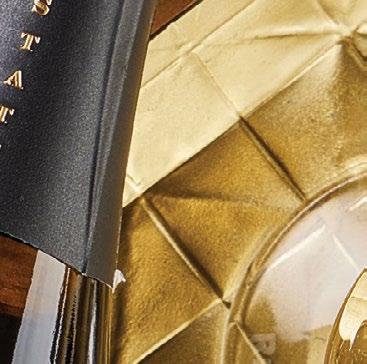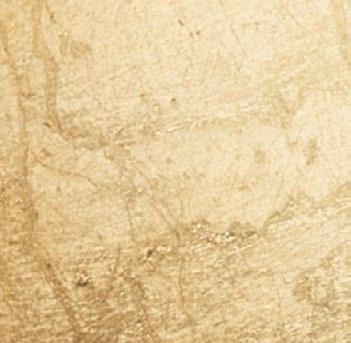AND A NEW PROFESSION
A UO institute addresses the crisis in children’s behavioral health

































































































































Celebrating Milestones
we ordered a huge bouquet
knew it was an important day, a very special occasion.
beautiful
others live their best lives.

We’ve been alongside Lila for many ups and downs, weddings and graduations, grandchildren’s birthdays, and even the passing of her husband. Through it all, we were there whenever she and her family needed us, managing her finances to give her peace of mind. Now, her 80th birthday was cause for celebration!
Vivian b.
Member since Aug 2021
in General Music
Sam r.
Team Member since Aug 2021
in Art and Technology
From working at our counters to studying in the classroom; from directing our stores to cheering in the stands; the people we serve — the students — are the very people who are The Duck Store.
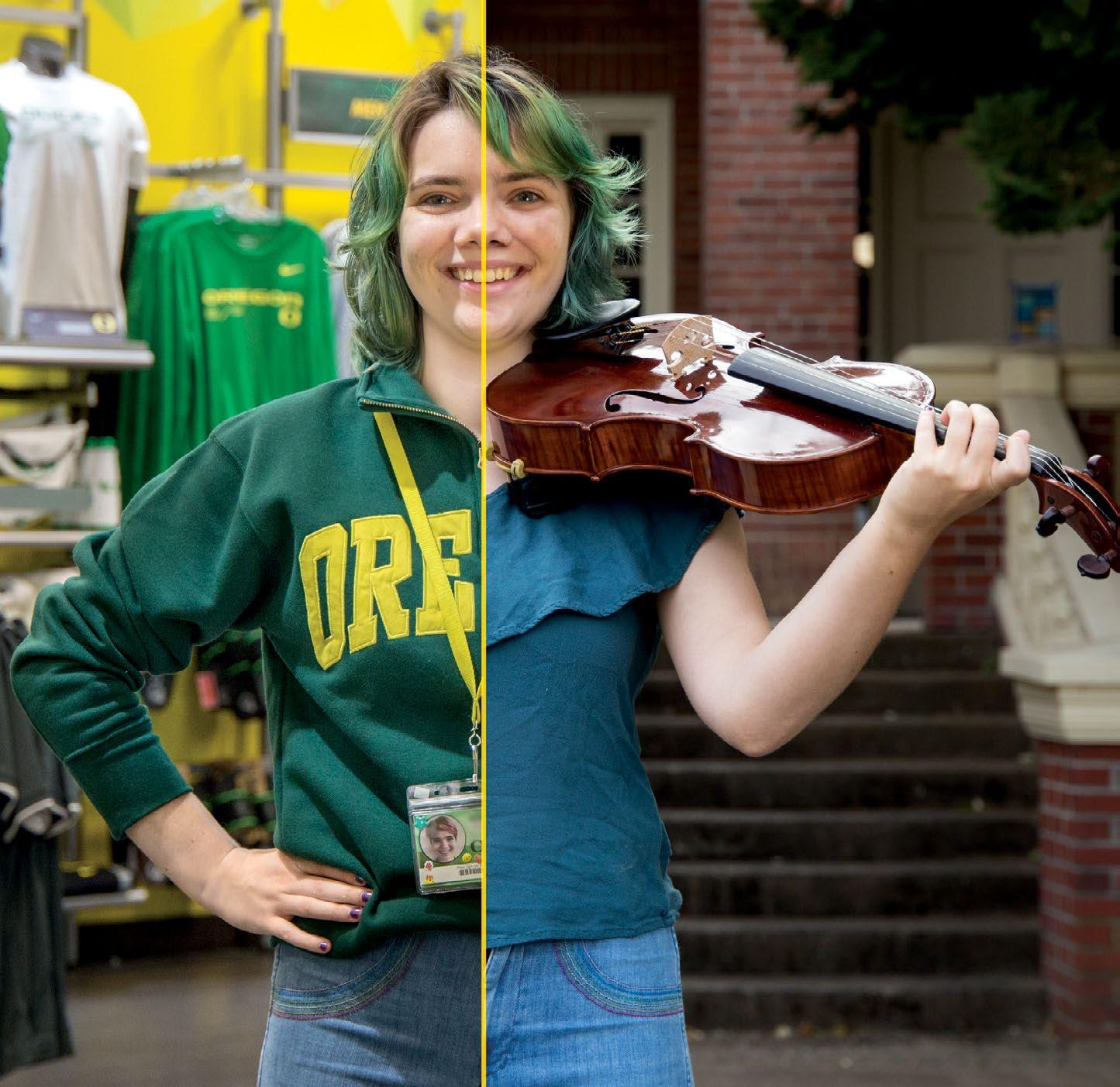


NEW HOPE, AND A NEW PROFESSION
The Ballmer Institute for Children’s Behavioral Health is poised to address the

health crisis facing
BY ALICE CALLAHAN
BRIGHT GREEN FUTURE
The launch of the Oregon Center for Electrochemistry heralds a focus on alternative energy underpinned by research, industry collaboration, and career readiness
 BY ED DORSCH
BY ED DORSCH


ON THE COVER
Launched in March with a $425 million gift from Connie and Steve Ballmer, the Ballmer Institute for Children’s Behavioral Health represents a bold new approach to improving the behavioral health and wellness of children and adolescents in Oregon and beyond


Better Together
Editor’s Note: On August 11, Michael Schill announced his departure from the University of Oregon to become president of Northwestern University. The UO Board of Trustees subsequently appointed Patrick Phillips interim president.

Fallmeans the University of Oregon campus is again bustling with activity, and we begin this academic year with a renewed sense of optimism and purpose.
We welcomed our largest, most diverse, and most academically qualified class of first-year students. They are benefiting from more academic offerings, state-of-the-art academic and recreational spaces, outstanding professors, new life-improving initiatives, and unique experiences—all to prepare them for fulfilling careers and making a difference. It is energizing to be together again.
For me, personally, it’s also exciting, and a great honor, to serve in my new role as interim president.
When I came to the University of Oregon twenty-two years ago, I was impressed by the sense of shared purpose and community. This is a university that seeks to expand the bounds of human awareness through cutting-edge research and creative practice while supporting a faculty of caring, transformative teachers who mentor our students. Over the last few years, this feeling has only grown. It’s a spirit we will continue to celebrate: we are the University of Oregon, for Oregon.
In my many roles at the UO—provost, biology professor, and acting director of the Phil and Penny Knight Campus for Accelerating Scientific Impact, to name a few—I have traveled extensively throughout Oregon and the country. Meeting with people in government, business, research centers, and other universities has made it clear to me that the UO plays a critical role that transcends the classroom, research lab, library, or concert hall. We are in a moment of intensifying change, in higher education and society as a whole.
It is abundantly clear that the world needs what the UO has to offer: knowledge, innovation, solutions, and progress. In short, impact. It is my mission to better demonstrate this value and redefine our role as a great public research university in service to the greater good.
Two shining new examples of our impact are featured in this issue of Oregon Quarterly. The Ballmer Institute for Children’s Behavioral Health will boldly address the heartbreaking mental health crisis affecting our youth, through the creation of child behavioral health specialists. The Oregon Center for Electrochemistry is developing green energy solutions while creating unprecedented hands-on opportunities for students. Both hold great promise for society. And both have been made possible by the amazing generosity of our alumni and friends.
Our position of strength is a testament to the heroic work of our faculty and staff over the last few years, the generosity and advocacy of our alumni and friends, and the flexibility and resilience of our students. It’s true—we are better together.
I feel very fortunate to lead the university at this time of great promise and opportunity. We will continue to build momentum behind our academic and research impact; our commitment to diversity, equity, and inclusion; and our relentless focus on student success. It is an exciting time to be part of the University of Oregon.
Thank you, and Go Ducks!
Patrick Phillips Interim President and Professor of Biology
NEW PREZ PACKAGES WITH CARE
Phillips helped assemble care packages for houseless youth at a UO Migration event in September, during which incoming students connected with other new Ducks from their area

On the Water, Breaking Ground

The Oregon Quarterly editor who chose to run a picture of Oregon rowers at Dexter Lake in the spring issue would probably be surprised at the historical symmetry of this selection. Fifty years ago in April, the Ducks’ 1972 varsity crew team appeared in a different national publication. The team took a stand against discrimination and supported Victoria Brown as the first female coxswain of the Pac-8 conference.
University of Washington coach Dick Erickson had demanded Oregon use a male coxswain [to race Washington]. Erickson didn’t care that Wendell Basye [UO law professor and Pac-8 faculty representative] had declared Victoria eligible. He didn’t care that Victoria had already piloted the Ducks to victory over Seattle University.

Oregon coach Don Costello asked the varsity team for our input, one oarsman at a time. The guys voted 7–1 to support Victoria.
Sports Illustrated and newspapers across the country covered the story. Some reporters were more than a little condescending. But Victoria handled the interviews with grace and had already proved she could do the job on the water.
Then came the passage of Title IX, prohibiting federally funded educational institutions from discriminating against students or employees based on sex, and lots of things changed. Wow . . . it feels great to be on the right side of history.
Bruce Paul, BS ’75 (history)
Leesburg, Virginia
Generations of Appreciation
As a loyal Duck and 1972 graduate of the UO School of Journalism and Communication, I just wanted to tell you how proud I am of the extraordinary work you are doing with Oregon Quarterly. My pride in the university goes far beyond my own outstanding experience. My greatgrandparents’ final resting place is Pioneer Cemetery on campus. My grandmother was a 1913 graduate and my late mother attended as well.
On behalf of all of them, as well as myself, I thank you and congratulate you for a job well done.
Stephen Robinson, BS ’72 (journalism) Olympia, Washington
We want to hear from you. Submit your letters by email to quarterly@uoregon.edu, at OregonQuarterly.com, or by mail to Editor, OregonQuarterly , 5228 University of Oregon, Eugene, OR 97403-5228. Published letters may be edited for brevity, clarity, and style.
PUBLISHER George Evano gevano@uoregon.edu
MANAGING EDITOR Matt Cooper mattc@uoregon.edu
CONTRIBUTING EDITOR Alice Tallmadge
CREATIVE AND PRODUCTION Oregon Media info@oregonmedia.com
PROOFREADERS Jennifer Archer, Sharleen Nelson
INTERN Ella Norton
WEBSITE OregonQuarterly.com
MAILING ADDRESS
5228 University of Oregon, Eugene, Oregon 97403-5228
EMAIL quarterly@uoregon.edu PHONE 541-346-5045
ADVERTISING SALES Ross Johnson, Oregon Media ross@oregonmedia.com



OREGON QUARTERLY is published by the UO in January, April, July, and October and distributed free to members of the alumni association and costsharing schools and departments. Printed in the USA. © 2022 University of Oregon. All rights reserved. Views expressed do not necessarily reflect those of the UO administration.
CHANGE OF ADDRESS
Alumni Records, 1204 University of Oregon, Eugene, Oregon 97403-1204; 541-302-0336, alumrec@uofoundation.org
ADMINISTRATION
Interim President Patrick Phillips, Acting Provost and Executive Vice President Janet Woodruff-Borden, Vice President for Equity and Inclusion Yvette Alex-Assensoh, Senior Vice President for University Advancement Michael Andreasen, UO Alumni Association Executive Director Raphe Beck, Vice President and Executive Director of Knight Campus Robert Guldberg, Vice President for University Communications Richie Hunter, Senior Vice President for Finance and Administration Jamie Moffitt , Director of Intercollegiate Athletics Rob Mullens, Vice President for Research and Innovation Anshuman Razdan, Vice President and General Counsel Kevin Reed , Vice President for Student Services and Enrollment Management Roger J. Thompson, Interim Vice President for Student Life Kris Winter
HONORING NATIVE PEOPLES AND LANDS
The University of Oregon is located on Kalapuya Ilihi, the traditional homelands of the Kalapuya people. Following treaties between 1851 and 1855, Kalapuya people were dispossessed of their indigenous homeland by the United States government and forcibly removed to the Coast Reservation in Western Oregon. Today, their descendants are citizens of the Confederated Tribes of Grand Ronde Community of Oregon and the Confederated Tribes of Siletz Indians of Oregon, and continue to make important contributions in their communities, at the UO, and across the land now referred to as Oregon.
The University of Oregon is an equal-opportunity, affirmative-action institution committed to cultural diversity and compliance with the Americans with Disabilities Act. This publication will be made available in accessible formats upon request.
Portland Branch
805 SW Broadway, Suite 1800 | Portland, OR 97205
223-7711 | tom.meagher@rbc.com
Bend Branch
1133 NW Wall Street, Building 2 | Bend, OR 97703
385-5026
Eugene Branch
pamela.j.carty@rbc.com
975 Oak Street, Suite 450 | Eugene, OR 97401
685-2015
brooke.johnsen@rbc.com

Your Central Oregon
OF ART
SCHNITZER MUSEUM OF ART UNIVERSITY OF OREGON ON EARTH: A FRAGILE EXISTENCE
April 2, 2022 – April 16, 2023
On Earth: A Fragile Existence highlights works from the Jordan Schnitzer Museum of Art’s permanent collection that reflect a multi-layered understanding of humanity’s role in our shared ecology with the non-human, or more-than-human, world.

MORE EXHIBITIONS FROM THE JORDAN SCHNITZER FAMILY FOUNDATION
JORDAN SCHNITZER MUSEUM OF ART WASHINGTON STATE UNIVERSITY
JUVENTINO ARANDA: ESPERÉ MUCHO TIEMPO PA VER
August 23, 2022 – March 11, 2023
In Juventino Aranda: Esperé Mucho Tiempo Pa Ver (I Have Waited a Long Time to See), the artist searches for identity as a “Mexican and second generation ‘American,’” among social, political, and economic struggles and notions of the American dream. left: Y Llegaron Las Flores (The Funeral) detail
JORDAN SCHNITZER MUSEUM OF ART PORTLAND STATE UNIVERSITY
THE ART OF FOOD
From the Collections of Jordan D. Schnitzer and His Family Foundation
August 30, 2022 – December 3, 2022
At some point in every artist’s career, they use food in their art. Come see this innovative exhibition!

Positive Fragmentation 7/14/22 – 12/11/22 180 works by Kehinde Wiley, Leonardo Drew, Kara Walker, Julie Mehretu, Terry Winters, and others. Eskenazi Museum of Art at IU • Bloomington, IN
Storywork: The Prints of Marie Watt 8/20/22 – 12/18/22
One of the most important Native American artists working today! Art Museum of WVU • Morgantown, WV
John Buck: Prints and Sculptures 8/24/22 – 12/18/22
A master of wood! Whether it is woodblock prints or sculptures — do not miss this exhibition! Brunnier Art Museum at ISU • Ames, IA

Louise Bourgeois: What is the Shape of This Problem? 9/6/22 – 12/3/22
One of the most important artists of our time! She burst through so many glass ceilings! 145 works, some never before seen!! Fisher Museum of Art USC • Los Angeles, CA
All Exhibitions from the Collections of Jordan D. Schnitzer and His Family Foundation provided at no cost to exhibiting museums
HAPPY AS A CLAM
Invertebrate zoology, offered spring and summer terms by the Oregon Institute of Marine Biology, immerses students in lectures, labs, and fieldwork in and around the coastal community of Charleston. Participants live and study at the marine biology station, where they get accustomed to early mornings. That’s when low tide leaves tide pools packed with marine finds—such as this clamshell marine biology major Katie Hurley collected in Shore Acres State Park.
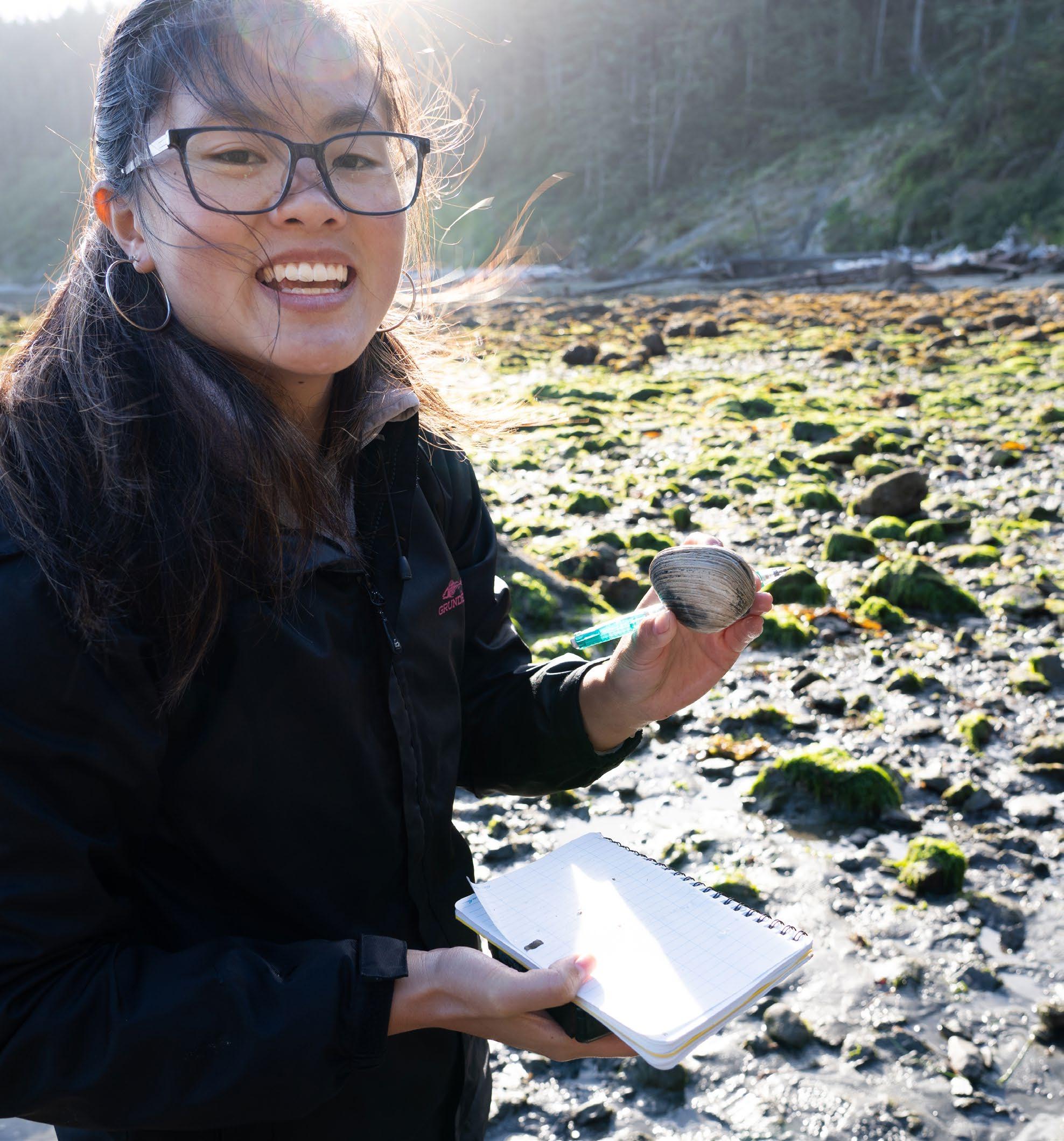
SPORTING DOG Meet
Thor, a two-year-old silver Labrador retriever who has joined the University of Oregon Police Department.
He’s a happy, curious, gregarious guy whose day job is explosive detection. And getting pets.
Thor lives with his handler Anthony Button, a UOPD officer who has been at the UO since 2015. For both, it’s their first time on a K9 team.
The duo gained celebrity during the World Athletics Championships Oregon22 in July. As he worked every day of the event, conducting bomb sweeps and staffing security gates, Thor became a go-to for a cuddle and a photo op for international athletes, many of whom were missing their own pups back home. Through his Instagram account, @uopd_thor, Thor even got a brief mention on the Ali on the Run podcast, a runners’ favorite.

Button says a highlight of the championships was meeting Team USA’s Brooke Andersen, the women’s gold medalist in the hammer throw. A few hours after winning her medal, Andersen spotted Thor, recognized him from Instagram and said she’d been looking for him all week for a photo (Thor’s own hammer, meanwhile, is made of plush and he would rather chew it than throw it).
For a young dog like Thor, consistent training is important, so Button regularly runs him through drills on campus and at home to keep his skills sharp. If you happen to see the pair this fall, stop and say hi. Thor loves making new friends—just leave the cat at home.
DIET AND AGING
University of Oregon scientist Kirstin Sterner has pondered aging and factors that cause it for, well, ages. She may soon shed light on the role of one variable—diet—in accelerating, slowing, or even reversing the aging process.
Sterner, a molecular anthropologist and associate professor in the Department of Anthropology, leads a team with geneticist Lucia Carbone of Oregon Health & Science University that received $424,000 from the National Institutes of Health to examine what happens at the molecular level to cause aging. They will test how different diets interact with one’s genes to influence aging.
The team studies life span changes in the chemical compounds that control genetic expression in different body tissues. As part of this, they are creating tools to compare an individual’s chronological age with the “biological age” of their genes. When one’s biological age is significantly greater than their chronological age, Sterner says, it suggests faster aging. With the funding, the team will incorporate data from liver tissue with previously generated data from brain and blood tissue to better understand how genes change with age across the body.
For Sterner, working in a team has proven as satisfying as progress with the project.
“Building these collaborations and sharing ideas with a diverse group of researchers trained in different fields has been one of the most rewarding parts of this project so far,” she says.
ACTS OF NATURE

After the Holiday Farm Fire burned 174,000 acres in the McKenzie River Valley in 2020, University of Oregon ecologist Lauren Ponisio and her graduate students sowed native plant seeds into burn piles, hoping to create habitat for bees and other pollinators. Ponisio recently revisited the site—owned by UO alumni Jim Russell and Jane Haake—and, following up on a story about the project in the spring Oregon Quarterly, reported both flora and fauna are thriving. Seeds sown into slash piles are “doing amazing,” she says, and “when we are out counting flowers, the plots are just hopping with pollinators.”

OSPREY ARE LAW SCHOOL’S RESIDENT RAPTORS

The start of spring term saw the return not just of students but an osprey couple who nested on a perch atop the School of Law, nurturing three eggs.
The law school ospreys have become “talon-ted” celebrities. A video camera positioned above the nest has provided livestream viewing—law.uoregon.edu/osprey—since its installation in 2018. The Professor Emerita Margie Paris Osprey Cam is named for retired dean Margaret “Margie” Paris, the first woman to hold the position at Oregon Law.
During the World Athletics Championships Oregon22, the birds drew coverage as fan favorites who rivaled Legend the Bigfoot—the championships’ fuzzy mascot—for affection. The osprey have also drawn attention on the law school’s Facebook page and enjoy a page of their own, the Oregon Law Osprey Group.
As in past years, the law school held a naming competition for the expected hatchlings, drawing more than one hundred suggestions.
Some submissions played off university notables—“Osprefontaine,” for example, and “Marcilynn Bird,” a reference to Marcilynn Burke, law school dean.
There were tributes to the late Supreme Court justice Ruth Bader Ginsburg, or “Ginsbird.” Legal puns proved popular—“Amicus Curiaesprey,” “Osprima Facie,” and “Quid, Pro, and Quo”—as did names referencing the court’s overturning of the constitutional right to abortion: “Roe, Wade, and Casey,” for example. “Ozzie” was a popular suggestion and, this being the home of the Ducks, “Huey, Dewey, and Louie.”
Unfortunately, by contest’s end a sad twist had changed the circumstances and left the ospreys’ fans dejected: only one chick survived. The winning name? “Solo.”
HANGIN’ WITH SPIDER-MAN
University
of Oregon English professor Ben Saunders went above and beyond in curating a new exhibit celebrating sixty years of Spider-Man, the web-slinging wonder of Marvel Comics.
When Spider-Man: Beyond Amazing the Exhibition opened in July at San Diego’s Comic-Con Museum, it included images culled from more than three hundred that Saunders scanned and digitized from his own collection of comics.
The installation focuses on both the fictional world of Spider-Man and the real history behind the stories. It features original art drawn for Spider-Man comics of all eras and thousands of artifacts from the superhero’s appearances in media. A multimedia experience covers the iconic character’s journey through popular imagination, including cinema, gaming, and animation.

One challenge that faced Saunders and cocurator Patrick Reed was the move of much of Marvel Comics’ archives of production art into private hands in the 1980s. Saunders acknowledged the generosity of collectors who loaned materials for the exhibit.
As director of the university’s groundbreaking comics and cartoon studies program, Saunders uses comics as a springboard to explore topics ranging from American history to the politics of censorship to the cultural influence of hip-hop.
“Comics are a narrative storytelling medium that is at least as old as manuscript culture. We’re talking about a culturally revealing and incredibly rich pedagogical resource, and one of the most effective forms of communication that human beings have ever devised,” Saunders says. “I wish I could tell my thirteen-year-old self that all of this geeky stuff matters.”
Sarai Villalobos, a UO lead field supervisor with Oregon Saludable: Juntos Podemos (“Healthy Oregon: Together We Can”), which supports SARS-CoV-2 testing for underserved Latinx communities, handed out roses to mothers getting tested on Mother’s Day weekend

Crunching the Numbers
Data scientists contribute to pandemic testing breakthrough for Latinx groups
BY MATT COOPERast year, University of Oregon researchers studied one aspect of the COVID-19 pandemic’s disproportionately high impact on Latinx people: participation in testing. They found that combining culturally informed outreach with well-located community testing sites tripled turnout.
The project’s success was driven by a university-wide collaboration that included data scientists from the UO’s Presidential Initiative in Data Science.
Data science is the sophisticated analysis of massive, complicated data sets. The field—which draws from mathematics, statistics, computer science, and more—is increasingly essential across industry, from auto production to medicine to banking.
In 2018, the UO officially prioritized data science with the launch of the Data Science Initiative, driving improvement and expansion of data science efforts in support of undergraduate and graduate education and university research.
Then came the pandemic—and the UO responded by tapping its data science expertise to serve the general public, as well.
In spring 2020, the university launched the COVID-19 Monitoring and Assessment Program (MAP), expanding the UO’s testing capacity for the coronavirus and making testing available to anyone in Lane County. More than 260,000 tests were provided through August 2022.
Parts of the program rely on UO experts in genomics, prevention science, and other areas. Data scientists solve the information challenges—that is, processing each patient’s information and lab results, reporting this information to patients and health agencies across Oregon, and analyzing virus trends to inform response.
The creation of information systems for such a sweeping program could reasonably take months, say Emily Beck and Jake Searcy, assistant research professors of data science. But due to the urgency of the pandemic, the public service was successfully launched through the university in just weeks.
Beck and Searcy exemplify the applicability of data science across fields. Beck, who has expertise in evolutionary genomics and a PhD from the University of Iowa, works with researchers to apply data science to biological problems. Searcy, who graduated from the UO in 2012 with a PhD in high-energy particle physics, worked in artificial intelligence for Ford Motor Company before returning to the UO to expand the ability of researchers to use AI. Both realized quickly that their ability to manage data would help provide the very backbone of a countywide coronavirus testing system run through the university.
Says Beck: “Everything from data organization to file structure to building reproducible information-gathering processes—the types of things you don’t even think of as skills because you’re so used to doing them as a data scientist were desperately needed.”
To study ways to increase testing by Latinx groups, researchers developed a grant proposal that won support from the National Institutes of Health RADx UP program, which supports response to the pandemic in underrepresented populations.
The team was led by Dave DeGarmo, research professor of prevention science; Leslie Leve, Lorry Lokey Chair in Education and professor of prevention science; and Bill Cresko, Lorry Lokey Chair in Science and professor of biology. Working with community partners, researchers set up testing at sites across Oregon and developed ways to ensure patient data gathered onsite was transferred to the testing lab on campus.
In assessing the impact of culturally informed outreach efforts, data scientists integrated testing results with surveys on patient participation and residence. They also tabulated statistics for the Latinx patient group as a whole and subpopulations across the nine counties in the study.
Data scientists created a computer algorithm to recommend locations for testing sites based on the number of Latinx people in the area. But the project was ultimately successful, Searcy says, because researchers also listened to community input on important parts of the study, including the location of testing sites.
“It wasn’t ‘Here’s this algorithm with the right answer,’” Searcy says. “It was, ‘Here’s an interesting idea that came from this algorithm. What’s the right thing for your community?’”
Matt Cooper is managing editor for Oregon Quarterly.When you think of your CPA, does “forward thinking” come to mind? Do they come to you with ideas for the future, or are they focused on last year’s tax returns? The CPAs at Kernutt Stokes consider the realities of today and opportunities for your business in the future.

more from your CPA. Get more with Kernutt Stokes.
Bend | Corvallis | Eugene | Lake Oswego

If your CPA only considers “what is” and not “what if,” maybe it’s time for a change.
Here’s an interesting idea that came from this algorithm. What’s the right thing for your community?
— Jake Searcy
Down to Earth
New CAS dean brings expertise on a warming planet, commitment to equity and access, and a knack for mushroom hunting
BY EMMILY BRISTOLHiker, amateur mushroom hunter—and marshmallow?
These are just some of the ways that Chris Poulsen, incoming Tykeson Dean of Arts and Sciences in the College of Arts and Sciences, is described by former colleagues at the University of Michigan.

Don’t let the descriptors throw you, though. Poulsen is as solid as his research, which centers on earth system models, similar to those used to project future climate scenarios. Poulsen’s research group uses the models to study past climates and how previous climate change events might inform the future.
At U-M, Poulsen was associate dean for natural sciences in the College of Literature, Science, and the Arts and the Henry Pollack Collegiate Professor of Earth and Environmental Sciences and Climate and Space Sciences and Engineering. He has published more than 130 peer-reviewed articles on topics including climate change through Earth history, mountain uplift-induced climate change, the dynamics of extreme past climates, and water isotopes as an environmental tracer. Poulsen received the university’s John Dewey Award for excellence in teaching and he is a fellow of the American Association for the Advancement of Science and the Geological Society of America.
The marshmallow reference refers to a tradition of U-M deans wearing team Halloween costumes. He was the marshmallow in a s’mores group. Another year he was the rock in a rock-paper-scissors trio.
“Of course, Chris was the rock!” says Alexandra Minna Stern, who worked with Poulsen when both were associate deans. “In all seriousness, Oregon will benefit from Chris’s deep commitment to addressing sexual and gender harassment in academia. Thanks
largely to him, the college designed and implemented new policies and support for faculty and graduate students experiencing hostile or microaggressive work environments. Chris is collegial, thoughtful, and attentive to details and the big picture.”
That big picture includes how to create equity for faculty and students and bring sustainability into the lab and other university functions. One of Poulsen’s last accomplishments at U-M was leading a report on ways for the college to become carbon-neutral in teaching and research.
Poulsen also reduced gender disparity in the faculty salary structure, organized trainings on preventing sexual harassment, and diversified faculty search committees. During his eight-year chairmanship of the earth and environmental sciences department, the number of female faculty members nearly doubled (from seven to twelve). As associate chair for graduate studies, he collaborated with the graduate school to bring underrepresented undergraduate students to campus to demystify applying for graduate school.
“Chris’s pioneering work in this area continued as he assumed the role of associate dean,” says Fiona Lee, who worked as associate dean of diversity, equity, inclusion, and professional development while Poulsen chaired the environmental sciences department. “Reaching beyond his own discipline, we worked with multiple departments in the natural sciences to increase diversity, equity, and inclusion among undergraduate students, graduate students, and faculty.”
An avid hiker and outdoor enthusiast, Poulsen grew up with his family on a remote hillside in Helena, Montana. “We had only three television channels, all with poor reception, and the nearest kids our
Poulsen’s first meetings included one with Janet Woodruff-Borden, acting provost and executive vice president

age lived a mile away on the other side of the mountain,” Poulsen says. “It was also very liberating. My brother and I would roam the hillside exploring and playing. I credit growing up in Montana for fostering my love of the outdoors and the natural world and my environmentalism.”

Poulsen received his BA in geology from Carleton College in Minnesota and his PhD in geosciences from Pennsylvania State University.
“The work that public universities do educating the next generation of leaders, creating new knowledge, and serving the public
is important and makes the world better, more just, more equitable, more sustainable,” he says. “Oregon is deeply committed to its public research mission, to student success, to addressing societal challenges, and to advancing diversity, equity, and inclusion. The opportunity to serve as the dean of CAS at UO seemed like the perfect fit for me.”
In his announcement of Poulsen’s hire, UO interim president Patrick Phillips said, “The search committee and I were struck by Chris’s experience as a leader in a college of similar size and complexity to CAS who also has the academic credentials and interests that align so well with UO priorities and initiatives. I am also pleased to be bringing someone to UO with demonstrated commitment to diversity, equity, and inclusion.”
Poulsen, his wife, Lea, and their three children are excited to start a new chapter in Eugene.
If his fungi foraging skills are any indication, Poulsen is ready for life in Oregon. On a summer vacation in Maine, he went mushroom hunting for the first time with his brother-in-law, a seasoned mushroom hunter, and found the coveted hedgehog variety. His brother-in-law was a bit cautious about eating them, but after consulting a guidebook Poulsen felt confident. “Only 3 percent of mushrooms are poisonous,” he says. “So I figured it was worth the risk.”
And the result? “It was delicious!”
Emmily Bristol, BA ’98 (English), is a strategic communications generalist for University Communications.

A Pipeline for STEM Students
A grant from the National Science Foundation will help guide promising students in the physical sciences to the workforce
BY LEWIS TAYLORWhen it comes to education and training for STEM careers after high school, not all students receive the support they need. A recently awarded National Science Foundation grant will help remedy that for sixty-four low-income students in Oregon.
The $4.3 million grant will provide financial and mentorship support to help low-income community college students pursue industrial research careers—which the US Bureau of Labor Statistics projects to be among the fastest growing employment sectors this decade, with even higher growth projections seen within Oregon.
The grant funds the Oregon Pathways to Industrial Research Careers program. Promising students in their final year at Lane, Umpqua, or Central Oregon community colleges will receive cross-institutional training, mentorship, and scholarships for
four years as they progress toward bachelor’s and master’s degrees from the University of Oregon. The first Oregon Pathways scholars will be recruited this fall.

“The program builds on our previous collaborations with the diverse student populations of community colleges and, particularly, the materials sciences and optics strengths of our undergraduate programs,” says Dean Livelybrooks, principal investigator of Oregon Pathways and former associate head of the Department of Physics.
Additionally, Livelybrooks says, Oregon Pathways will help meet the need for scientists and engineers in renewable energy storage technologies, onshore chip manufacturing, optical-computational applications, high-performance polymers, sensing technologies, and other specialties. It culminates with master’s degree training through the Phil and Penny Knight Campus for Accelerating Scientific Impact and its Knight Campus Graduate Internship Program (KCGIP). The accelerated master’s degree program includes a nine-month paid internship that provides graduates with work experience, paving the path for industrial careers.
In addition to the Knight Campus and the College of Arts and Sciences (through the Department of Physics and Department of Chemistry and Biochemistry), Oregon Pathways is supported by the College of Education (through the Department of Education Studies) and work by UO STEM CORE—Science, Technology, Engineering, and Math Careers through Outreach Research and Education—led by
Bryan Rebar, coprincipal investigator and associate director of the program.
Oregon Pathways builds on previous NSF-funded programs that boosted the number and diversity of community college students transferring to the UO and showed that UO physical sciences programs can collaborate with community colleges, says Stacey York, coprincipal investigator for the grant and director of the materials science tracks in the KCGIP.
The KCGIP, which combines hands-on training in cutting-edge science and professional/leadership training, will be key to setting up students to be among the most competitive job seekers on the market, York says. The program has a ninety-eight percent graduation rate and students earned an average annualized salary of $67,000 in 2021. Oregon Pathways aims to increase enrollment in the KCGIP by students from underrepresented groups, including from low-income backgrounds, by twenty percent after six years.
The scholars in Oregon Pathways will collectively receive $2.8 million in scholarship funding and mentorship/ advocacy from KCGIP students and alumni. Pathways students will be eligible for up to $45,000 each in scholarships, based on unmet financial need, throughout the four-year program.
Oregon Pathways will help lowsocioeconomic students confront the challenges they face, including limited resources, structural barriers, access to informal networks, and the transition to a new environment.
The program also features research led by Jenefer Husman, coprincipal investigator and a professor in the education studies department. Researchers will study how students’ perception of their future is influenced by faculty and peer mentorship, cohort-building activities, and internship programs.
Lewis Taylor is director of communications for the Phil and Penny Knight Campus for Accelerating Scientific Impact.
LEFT Knight Campus Graduate Internship Program students talk conflict-resolution strategies during orientation week
We work so you can





Better Athletes, Healthier Humans
Findings from a lab inside Hayward Field benefit pro competitors and weekend warriors
BY ROSEMARY HOWE CAMOZZIayward Field at the University of Oregon draws track-and-field athletes from around the globe—from world-record breakers to runners who are thrilled just to be in the middle of the pack.
But this isn’t the only action at the stadium. Tucked into the northwest side of the facility, the Bowerman Sports Science Center hosts faculty members and graduate students who explore the mechanics of the human body and how it reacts to physical stress.
Local runners, both amateur and professional, contribute to—and benefit from—this groundbreaking research.
“If someone has a hamstring injury, how can we accelerate their return to activity?” says BSSC director Mike Hahn, an associate professor in the Department of Human Physiology. “If they have an Achilles tendon injury, should we still use the model of rest and slow recovery, or can we speed that up? If we see indications of pending injury, can we change their training practice to reduce the risk?”
FORCE, ACCELERATION, VELOCITY, TORQUE
Many staff and students in the BSSC play key roles for the UO in the Wu Tsai Human Performance Alliance. The alliance, made possible by a gift from the Joe and Clara Tsai Foundation, is based at Stanford University and comprises six founding institutions. The alliance translates research into peak performance to benefit human health. The UO’s efforts are centered in the Phil and Penny Knight Campus for Accelerating Scientific Impact but extend into several areas on campus.
Hahn, PhD ’03 (exercise and movement science), a member of the Knight Campus, says the BSSC enables UO scientists to contribute
to alliance projects while working at the forefront in assessment of athletic performance.
The biomechanics laboratory features a treadmill with embedded force plates that is paired with a camera-based motion analysis system. After markers are placed on various bony landmarks of an athlete such as an ankle or knee, cameras record motion to a computer, allowing for a dynamic three-dimensional view of the body. “The force plates measure how much force you’re putting on the ground and in which direction,” Hahn says. “We take that information and the motion of the body to calculate how much force and torque is produced by the ankle, knee, and hip.”
The facility’s indoor track also has embedded force platforms and cameras that record the motion of markers placed on the body, as well as sensors that measure muscle activation.

The center’s Biodex machine measures the torque output from the joints and how stable they are, as well as the force produced by muscles. MRI scans of the lower limbs enable researchers to create a 3D picture of tissues in the body, then add data gathered while the person is running to create a mathematical model of their musculoskeletal system.
Says Hahn: “As we look at the patterns of how the quads and hamstrings fire, we can compare those to the physics of what’s going on in the joints and calculate how much force is trying to stretch the ACL or how much force is crossing over the Achilles tendon.”
TESTING ATHLETES—AND CLOTHES—IN EXTREME CONDITIONS
Hahn is also collaborating with a colleague from the University of Wisconsin to design a prosthetic foot that is functional for both walking
and running. When a prosthesis user is walking, they need a heel component and a toe component, but when they run, he says, they need only the toe component.
Other labs include an environmental chamber where athletes can perform at high altitude or in extreme heat, cold, humidity, or wind, and where clothing companies can test equipment in those conditions. In the exercise physiology lab, athletes sit in hot tubs or saunas for extended periods so scientists can test the cardiovascular response to heat and compare it to that of exercise.
Researchers use ultrasound to study cardiovascular physiology, measuring arterial blood flow to see how it changes with heat and stress. Another machine measures bone density, which is important not just for older people but for athletes who may overtrain and lose bone density because the body starts reabsorbing minerals, increasing the risk of stress fractures.
Hassan Mead, a professional runner with the Oregon Track Club who lives in Eugene, says training at the BSSC has been “my biggest advantage.”
Mead competed in the 5,000-meter race at the 2016 summer Olympics in Rio de Janeiro. He has used the center for lactate threshold and VO2 testing, which determines the rate of oxygen consumption during exercise. The testing has confirmed his training plan.
“As a distance runner, it’s important to be very energy-efficient,” he says. “We’ve done [testing] every four years and it’s still confirming that we’re on the right track.”
In another running study, BSSC faculty and staff worked with about forty local runners, offering them VO2 max and lactate threshold tests, biomechanical assessment of running gait, and injury risk assessment.
“We love getting the local community involved in the research,” Hahn says.
REAL-WORLD RESULTS
Graduate student Rachel Robinson knows a thing or two about running-related injuries.
As a physical therapist, she’s seen the gamut of what can go wrong on the trail. She’s become so interested in how the body functions and how injuries happen that she’s now working on a PhD in human physiology. She’s co-teaching a human physiology class for undergraduates and helping with a study that uses wearable sensors to measure biomechanics outside the lab.
Mike Hahn, director of the Bowerman Sports Science Center“We’re sending runners from the community out on trails and roads to get a better sense of what’s happening when they’re out there,” Robinson says.
Small sensors that measure acceleration are placed on the runners, and their shoes are fitted with a loadsol—a small version of a force platform. Heart rate monitors and a GPS are also attached to the runner. The results from these runs are compared with measurements made with the runner in the lab.
Another scientist at the BSSC is examining the performance of shoes themselves—shoes with cleats, that is.
Emily Karolidis, a second-year PhD student studying footwear biomechanics, played soccer in high school. She wants to use her knowledge of biomechanics to design better footwear for women and hopes to work in a lab that helps athletic companies design better products.
“The prevalence of injuries among female soccer players was very clear,” Karolidis says. “Female athletes aren’t getting the attention they deserve.”
ALL IN FOR ALL AGES
Hahn is also collaborating with Bev Smith, BS ’88 (physical education), executive director of Kidsports and former UO women’s basketball coach, on various efforts that connect university experts with youth to talk health and wellness. Faculty and grad students teach kids the basics about nutrition, hydration, training, and what the body should feel like after exercise.

“If we can get it into their minds early that recovery after practice as a twelve-year-old can be the same as recovery after practice as a twenty-five-year-old, that would be great,” Hahn says. “They need to know that there’s nutritional benefit to eating good foods at good times to have fuel in the tank, not just so they can have a good practice, but also so they can recover quickly. We feel like there’s an opportunity for the kids to learn how to make good decisions.”
Rosemary Howe Camozzi, BA ’96 (magazine), is a freelance writer and editor in Eugene.
We love getting the local community involved in the research.
— Mike Hahn
Leilani
Sabzalian
ASSISTANT PROFESSOR OF INDIGENOUS STUDIES IN EDUCATION
 BY MATT COOPER, OREGON QUARTERLY PHOTO BY NIC WALCOTT, UNIVERSITY COMMUNICATIONS
BY MATT COOPER, OREGON QUARTERLY PHOTO BY NIC WALCOTT, UNIVERSITY COMMUNICATIONS
Indigenous
students deserve Indigenous teachers. This philosophy drives the University of Oregon Sapsik’wałá Education Program, which Leilani Sabzalian, of the Alutiiq people of southcentral Alaska, leads with Professor Michelle Jacob, of the Yakama Nation in Washington. In a collaboration between the nine federally recognized Tribal Nations in Oregon and the College of Education UOTeach master’s program, Indigenous students are trained to teach in Indigenous communities (“Sapsik'wałá” pronounced “sahp-seekwuh-THLAH,” means “teacher” in Ichishkíin/Sahaptin, a language traditionally spoken along the Columbia River in southern Washington.)
“Our motto is: ‘Education strengthens our people,’” Sabzalian says. “We model how to put Indigenous pedagogies and knowledge at the center of teaching. Our students aren’t there to learn just what I think is important—we invite them to turn toward their own communities and ways of life that are full of brilliance.”
One venerable Indigenous pedagogy is storytelling. Sabzalian shared a story herself—of an Indigenous youth in public schools whose absences prompted mischaracterizations of laziness and disinterest by a principal; in fact, the youth was fulfilling ceremonial obligations in their community, a show of maturity that should have been applauded.
“Public schools don’t typically value the knowledge and culture of Indigenous youth,” Sabzalian says. “It’s vital that our students see their knowledge and culture as a source of strength before they become teachers.”
AGE-OLD WISDOM
Another Indigenous pedagogy: learning from Elders.
A new program feature called Grow Your Own prioritizes multigenerational instruction by gathering high schoolers interested in the program with UO undergraduates, master’s students, alumni, and Elders. One revered mentor—Yakama linguist Tuxámshish Virginia Beavert, PhD ’12 (linguistics)— turned one hundred last November.
“Having our students in community with an Elder is invaluable,” Sabzalian says. “But those youth perspectives are just as important. They teach us whether what we think is important is actually relevant to them.”
TRIPLE DUCK TURNED TEACHER
Sabzalian was adopted as a child by a Eugene-area white couple. Although she was loved, she says, she grew up feeling disconnected from her Indigenous identity, community, and culture.
That changed at the UO, after Sabzalian enrolled in the college to become a teacher. On her way to bachelor’s and master’s degrees and a doctorate, she embraced Indigenous studies—and her identity. She eventually visited her homeland, the Native Village of Chignik, and met her biological mother’s extended family.
“I had to work hard for my knowledge of Indigenous studies and to feel good about myself as an Indigenous person,” Sabzalian says. “I used to think of that as a deficit, that I wasn’t as Indigenous as other people. Now, I realize it’s a strength. I worked my way back into my knowledge and relations.”
PERSONAL PROJECT, PROFESSIONAL VALUE
Sabzalian is researching her life and the continuing journey to reconnect with her homeland, language, and roots.
“Although it’s a personal project, it has value for the future teachers I work with,” she says. “It takes courage and humility to reconnect with your community. By modeling that, I’m showing there’s always time to go back and talk to your aunties or connect with other relatives. There’s time to learn about your language and homelands and those are sources of power for you.”
BOOKMARKS

Latest titles of interest from alumni and faculty authors. Visit oregonquarterly.com/bookmarks for more, or to submit a book for consideration.
Leilani Sabzalian, of the College of Education, joins a half-dozen Indigenous faculty members who recently authored books on Cherokee nationhood, Sāmoan womanhood, Yakama storytelling, and more.

X Indigenous Children’s Survivance in Public Schools by Leilani Sabzalian, BA ’02 (education studies), MEd ’03 (educational leadership), PhD ’15 (critical, sociocultural studies and education). Leilani is Alutiiq and assistant professor of Indigenous studies in education.

X Anakú Iwachá: Yakama Legends and Stories coedited by Tu xámshish Virginia Beavert, PhD ’12 (linguistics), Professor Michelle Jacob, and Joana Jansen, MA ’04, PhD ’10 (linguistics), Northwest Indian Language Institute. Tu xámshish is a member of the Yakama Nation and Distinguished Elder Educator in the Sapsik'wałá Program in the College of Education.

X Bloody Woman by Lana Lopesi, a Sāmoan and assistant professor of Pacific Islander studies

X Stoking the Fire: Nationhood in Cherokee Writing, 1907–1970 by Kirby Brown, a citizen of Cherokee Nation of Oklahoma and associate professor of Native American literatures

X The Auntie Way: Stories Celebrating Kindness, Fierceness, and Creativity by Michelle Jacob, a member of the Yakama Nation and professor of Indigenous studies

X The Tunica-Biloxi Tribe: Its Culture and People (Second Edition) edited by Brian Klopotek (Choctaw descent), John Barbry (Tunica-Biloxi Tribe), Donna M. Pierite (Tunica descent), and Elisabeth Pierite-Mora (Tunica-Biloxi Tribe). Klopotek is associate professor of Indigenous, race, and ethnic studies.

NEW HOPE,
and a New Profession
The Ballmer Institute for Children’s
Behavioral Health is poised to address the youth mental health crisis
 BY ALICE CALLAHAN
BY ALICE CALLAHAN
Over the course of seventeen years as a school counselor in Eugene, Sara Matteri has supported students through just about every kind of challenge a kid can face. When she started as a high school counselor in 2005, the big ones were truancy, teen pregnancy, and drug and alcohol use, in addition to managing students’ class schedules and helping them plan for the future. Says Matteri: “It was working on kids getting to school, staying in school, and getting the required classes they needed to get the diploma.”
But in the span of her career, Matteri saw a dramatic shift in the size and scope of difficulties facing youth. By 2012, more and more teens were coming to her in crisis, sometimes harming themselves and often unable to afford mental health services. The COVID-19 pandemic layered on
isolation, disruption in school support, grief over the deaths of parents and grandparents, and increasing food and housing insecurity, all of which have had a disproportionate impact on children of color.
The same trends Matteri saw in Eugene have been reflected in nationwide statistics. The proportion of high school students experiencing persistent feelings of sadness or hopelessness jumped from 26 percent in 2009 to 37 percent in 2019, and then 44 percent in 2021, according to the Centers for Disease Control and Prevention. In 2009, 14 percent of teens had seriously considered attempting suicide; by 2021, that number had grown to 19 percent—and the risk of suicide was even higher for girls and for teens identifying as gay, lesbian, bisexual, or questioning their sexual identity, the CDC found.
Youth in America are in crisis. Last year, US Surgeon General Vivek Murthy issued a public health advisory calling youth mental health one of the most pressing issues of our time, and a coalition of pediatric health groups declared a national emergency in child and adolescent mental health.
At the University of Oregon, faculty has watched this crisis develop, too. They have seen it in their research, among their students, and at a behavioral health clinic that serves the public. College of Education researchers funded by the National Institute of Mental Health examined the pandemic’s impact earlier this year; they found 25 percent of middle schoolers surveyed in March, April, and May had considered self-harm or suicide over the preceding week, says Beth Stormshak, Philip H. Knight Chair and professor in the Counseling Psychology and Human Services department.

But across the university, there is also deep expertise in education, prevention, neuroscience, and psychology, and—bolstered by an unprecedented gift from two university benefactors—new resolve to turn the tide.
UO Expertise Meets an Extraordinary Gift

Last year, a small group of faculty members from the Department
of Psychology and the College of Education logged onto Zoom from home offices and met in backyards to start brainstorming solutions to the youth mental health crisis, recalls Jennifer Pfeifer, a professor in the Department of Psychology. There was consensus that the response must expand the mental health workforce, accelerate research and innovation, and incorporate schools and community organizations to reach youth.
Support and encouragement came from university administrators, colleagues in K-12 and higher education, legislators, Governor Kate Brown’s office—and two of the university’s staunchest supporters, Steve and Connie Ballmer, BS ’84 (journalism).
“When we heard there might be the opportunity to dream really, really big, it was reaffirming to see that you could bring folks together from across the university, and we all really quickly got on the same page,” says Pfeifer, who studies youth and adolescent behavior. “If we want to have an impact, we need to try something different.”
On March 1, the university announced The Ballmer Institute for Children’s Behavioral Health, funded by an extraordinary gift of more than $425 million from the Ballmers. In June, the university finalized the purchase of a nineteen-acre campus in northeast Portland, giving the Ballmer Institute its home. Formerly the campus of Concordia University, the Portland location centers the institute in Oregon’s most population-dense and diverse region and allows for a close partnership with Portland Public Schools.
“The Ballmer Institute is built on the foundation of established prevention work and evidence-based interventions
in the College of Education and the Department of Psychology,” says Stormshak, a longtime researcher in the college who studies youth risk factors and family-centered interventions.
The institute will create a new profession of child behavioral health specialists, with a bachelor’s degree program that prepares graduates to work with youth and infuses Oregon’s mental health workforce with about two hundred new graduates each year. The institute will also offer a graduate certificate program for current educators to level up skills in areas such as teaching students about self-regulation and healthy relationships—including those in online and social media spaces—and offering trauma-informed support for youth.
The institute will hire ten tenuretrack faculty members who research child and adolescent behavioral health, with a particular interest in those with expertise in addressing the needs of historically and persistently underserved communities. An additional fifteen clinical faculty members will supervise students’ hands-on training in schools and other community settings. The Ballmer gift also includes a $100 million endowment to support student scholarships and reduce financial barriers for Oregonians who want to enroll in the program.
Creating a New Profession
Most careers in mental and behavioral health require a master’s degree or doctoral training, so the idea of preparing child behavioral health specialists to enter the workforce with a bachelor’s degree is innovative, says Julie Wren, associate director of the Ballmer Institute. She likens it to the field of nursing, which provides opportunities to practice at associate, bachelor’s, and graduate degree levels.
Faculty has outlined a bachelor’s degree program that will begin with two years of core education courses, followed by two years at the Ballmer Institute campus in Portland. There, students will complete ninety credit hours of coursework in child
A PATH FOR KIDSto Get Support
Longtime University of Oregon benefactors
Steve and Connie Ballmer, BS ’84 (journalism), have a legacy of building partnerships that support youth. With a gift of more than $425 million, the cofounders of Ballmer Group Philanthropy have made possible The Ballmer Institute for Children’s Behavioral Health, a bold new approach to address the behavioral and mental health care needs of Oregon’s children.
OQ: What inspired you and Steve to make such a generous, amazing gift?
Connie Ballmer: Our country is experiencing a mental health crisis, and UO had a big idea and vision to help make a difference—informed by its deep relationships with Oregon’s school systems and policy makers. Through our work at Ballmer Group Philanthropy, we focus on the needs of kids, and here we saw a pragmatic and possible path for more kids to get support.
OQ: Why do you think it’s a smart move to focus on the workforce?
CB: Addressing behavioral or mental health issues always starts with people—we can’t heal people without more educated, compassionate practitioners. UO is strategically thinking about how to bring more people to this field, how to more quickly and efficiently train them, and how to ensure they find meaningful work after getting their degree.
OQ: What are your hopes for this project?
CB: I hope UO students who are interested in behavioral health will be excited by this program and see some meaningful career pathways. I hope the Ballmer Institute maintains a close partnership with Oregon’s K-12 system, learning what is needed and providing the tools to provide better care. Most importantly, I hope we create a better system for children to thrive by having access to counseling and supports if they find themselves in need.
OQ: You’ve stayed involved as a trustee, an advisor, and a donor. What makes you excited about the UO?
CB: Although I don’t live there now, I am forever an Oregonian. UO plays an important role in the future of Oregon—harnessing the brilliance and energies of Oregon’s youth, attracting more talent to the state, and training tomorrow’s workforce. We were impressed with UO’s plan for how to begin addressing mental health needs, and it is our privilege to enable this vision and support Oregon’s schools and students.
behavioral health and more than seven hundred hours of practical fieldwork, supervised by clinical faculty. Pending state approval of the program, Wren anticipates welcoming a small cohort of students to the Portland campus in fall 2023, beginning with current UO undergraduates. Once the program is established, they also plan to offer admission to transfer students from other colleges and universities, including community colleges.
Students will take required courses in areas such as counseling, screening and risk assessment, ethics and professional practice, family supports, and cross-cultural skills. They’ll also be able to take courses in subjects including neurodiversity, substance use, and working with historically underserved groups such as LGBTQ and racial and ethnic minority communities.
Randy Kamphaus, a UO professor of school psychology and acting executive director of the Ballmer Institute, says students “will take a variety of courses that address unfairness, discrimination, and marginalization that reside in societal structures including schools.”
Through supervised fieldwork, students will put curricula directly into practice, first in schools but expanding to community organizations, health clinics, and other settings.
The program will partner with Portland schools with the greatest need, where the trainees’ supervised practice will help them, Pfeifer says, “develop cultural awareness and humility in working with youth from a range of diverse backgrounds and family structures.” Clinical faculty will also be available as mental health professionals to provide additional services in the schools where they supervise Ballmer Institute trainees.
Portland Public Schools welcomes the partnership with the Ballmer Institute, says Jey Buno, interim chief of student support services. It will bring opportunities for professional development for staff and the chance to collaborate in designing and implementing a supervised undergraduate training program in Portland schools.
“The focus is on providing skills to respond to students regardless of race and language, experience, and support,” he says, and the Ballmer Institute’s emphasis on recruiting diverse faculty and providing culturally responsive training will help ensure that the program can meet the needs of all school communities.
If we want to have an impact, we need to try something different.
Jennifer Pfeifer, professor, Department of Psychology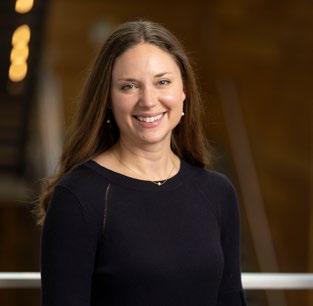

At the institute, future child behavioral health specialists will learn to provide evidence-based practices that promote well-being and help prevent mental health issues. For example, they may use tools such as the Family Check-Up, a brief intervention program and web-based app developed by College of Education faculty that reduces parental stress and improves family relationships.
They will teach youth to identify and regulate emotions, set goals, problem solve, practice mindfulness, and build healthy habits for sleep, eating, physical activity, and digital media use. They’ll be able to identify students who can benefit from early intervention or who need to be referred to more advanced mental health providers. And they’ll learn to collaborate with other professionals and connect families facing financial stress or food insecurity to community resources, Pfeifer says.
“Having more trained specialists in the building would be huge,” says Matteri, who loved her work as a school counselor but found that the level of need frequently exceeded her capacity. She was often tasked with serving as many as 550 teens, more than double the American School Counselor Association’s recommended ratio of one counselor for every 250 students. Her experience is common; in the 2020–21 school year, the average ratio was one counselor per 415 students in the US, according to the association, and school psychologists are similarly overburdened.
“I just felt depleted,” Matteri says. “I felt like I was a water balloon that kept getting holes poked in me, and I was just slowly leaking until there was water coming out from everywhere.”
The child behavioral health specialists trained at the Ballmer Institute will be ready to join the existing teams in schools, bringing expertise in mental health prevention and promotion and expanding the capacity to meet student needs. “There are so many dedicated educators and mental health professionals that are already in the school system,” Pfeifer says. “We’re not trying to replace any of that work—we’re trying to lend a hand.”
Creating Pathways for Change-making Students
The work of the Ballmer Institute is primarily about meeting the needs of youth, but it also supports young adults driven to make a difference in the lives of others. Pfeifer predicts that “demand will be off the charts” for students applying to the program.
“It’s a remarkable thing about college-aged, emerging adults; there is this drive and a fundamental need to contribute,” Pfeifer says. The students in her undergraduate psychology courses want to help people, and it can be disappointing for them to learn that a bachelor’s degree in psychology generally won’t equip them with practical skills for working directly with children and families, she says.
Likewise, Stormshak notes, students in the College of Education’s family and human services program will have the opportunity to apply to the Ballmer Institute, gaining experience and on-site training in an urban setting to refine behavioral health skills used with children and families.
Some students may find that being a child behavioral health specialist is a lifelong career. Others may choose to pursue graduate training in social work, counseling, school psychology, or prevention science, Wren says.
By creating a bachelor’s level pathway with significant scholarship support, the Ballmer Institute will increase access for students who want to work in mental and behavioral health, a field that is disproportionately white and not representative of the diversity of the communities it is meant to serve.

Says Pfeifer: “If we can broaden access by designing a program that provides really specific instruction at an appropriate skill level, we can increase and diversify the behavioral health workforce that can work with youth in schools and other public health settings.”
Having watched the seeds of an idea grow into reality through collaboration and financial support, Pfeifer can’t help but think even bigger. “Part of dreaming big is thinking in the back of your mind that if we can make it work in Oregon, if we can show that it works here, then maybe that will help other states,” she says. “What could this look like on a national level?”
Alice Callahan is a freelance writer in Eugene whose work appears in publications including the New York Times, the Washington Post, and Knowable Magazine.

I just felt depleted. I was a water balloon that kept getting holes poked in me.
—Sara Matteri, school counselor
“The focus is on providing skills to respond to students regardless of race and language, experience, and support.”
—Jey Buno, interim chief of student support services, Portland Public Schools
FUTURE Bright Green
BY ED DORSCH PHOTOS BY CHRIS LARSEN, UNIVERSITY COMMUNICATIONSAtthe Oregon Center for Electrochemistry, University of Oregon students and
faculty members research how energy is generated, stored, and transported. And they’re leading the way for sustainable energy.
Lean, green, and innovative, the OCE also prepares students for success in a field that’s in high demand for industry. Ultimately, these UO faculty members, students, and alumni are helping address climate change.
Thanks to a $5 million gift from Gordon and Betty Moore, the future of the OCE—which started in 2019—is looking bright. Gordon Moore is cofounder of Intel Corporation, a company also known for innovation-creating, world-changing technology.
“We are very grateful to the Moores for this generous gift,” says Patrick Phillips, interim president of the university.
“The OCE’s collaborative, forward-thinking work reflects

the shared purpose and community of our university and capitalizes on our strengths to fill a critical national need.
“These faculty members are leading the way for sustainable energy, through their research and by empowering students to start careers aimed at making a real difference in the world. Thanks to the Moores’ gift, we continue to build faculty strength in this area and broaden the UO’s impact through efforts such as our Environment Initiative.”
Energy is central to everything we do, says Shannon Boettcher, an alumnus and professor in the Department of Chemistry and Biochemistry, and the OCE’s founding director. “Electrochemistry is the key to developing a sustainable economy, reducing carbon in our atmosphere, and mitigating climate change.
“Gordon Moore is certainly one of my heroes, and we hope to make Gordon and Betty proud of this investment. It amplifies everything and allows us to think bigger.”
PhD student Grace Lindquist holds the active layer in a new type of alkaline-membrane-electrolyzer technology that could dramatically lower the cost of hydrogen production by delivering higher efficiency without using precious metals

Thinking bigger, says Boettcher, means attacking the most important science problems, translating discoveries into patents, startups, and commercial products. It means expanding industry connections and launching more student careers. Ultimately, Boettcher hopes, it will all add up to widespread change—in our economy, industry, policy, and technology—that stops climate change in its tracks.
Electrochemistry researchers study the relationships between chemical change and electricity. If a chemical reaction creates electricity, or vice versa, that’s electrochemistry. Electrochemists explore how to make better batteries (and reuse and recycle them). They study devices that convert electric energy into green hydrogen that could fuel trucks, ships, and planes—and produce sustainable chemicals, products, and fertilizers.
They seek ways to create better, lower-cost catalysts, fuel cells, and medical and environmental sensors. Electrochemists use electricity to deposit metals on structures as large as bridges and as small as the nearatom-scale wires inside of computer chips. They devise ways to stop corrosion, recycle metals, and clean water. Yet advanced training in electrochemical science and technology is sorely lacking, says Boettcher, because it doesn’t fit neatly into a single traditional disciple.
He and his colleagues are making the UO an international resource and leader in this field. Based on the growing reputation of the OCE and the success of graduates, they’re off to a great start.
FINDING SOLUTIONS
Wind, solar, and wave energy is intermittent and difficult to store and transport. Alternative fuels like hydrogen aren’t much of an alternative if they are produced from coal and natural gas. And many current industrial processes, which account for approximately one-third of US energy consumption, are difficult to convert to run on renewable energy.
In OCE’s laboratories in the spacious, daylit top floor of the Lewis Integrative Science Building, students and faculty members search for solutions that will make green renewable energy work—and help industries operate more sustainably.
They explore fuel cells, carbon-dioxide capture technology, and hydrogen production. They help companies develop batteries manufactured in greener ways. And they work to make current technology better, cheaper, and more efficient—for example, researching better methods for producing steel and chlorine.

The National Science Foundation recently awarded the OCE with funding for its Center for Interfacial Ionics, and they’re exploring how ions transfer into solids—a fundamental action for batteries. The researchers are also using bipolar membranes to separate water into acid (protons) and base (hydroxide). These can be used to capture carbon from the
atmosphere, deacidify the ocean, and create more efficient industrial electrochemical processes.
For another project, they use sunlight to drive photochemistry, effectively combining a solar cell with an electrolyzer. The goal: to develop a device that generates green hydrogen using only water and sunlight, at a low cost—and a massive scale.
OCE research involves faculty members at the UO and from around the world, as well as large corporations and small startups. Students play key roles, gaining professional experience while participating in groundbreaking—and industry-changing—science.
“My research has a very clear societal impact that aligns with my passion and my goals,” says PhD candidate Grace Lindquist. “We have electrolyzer companies reaching out to us to advise them on technology and help them bring products to market.”

Lindquist studies electrolyzers that split water molecules into hydrogen and oxygen. Although industrial electrolysis is commercialized, it is far from perfect. Lindquist’s work is helping companies produce hydrogen in ways that are more efficient, economical, and sustainable.
Industries at the vanguard of the green revolution desperately need employees with fundamental science and engineering experience and professional training, Boettcher says. The OCE ensures students have both, a key strategy for accomplishing a goal that’s simple but bold: become the best place in the world to get educated in this crucial area, helping transform industry—and the world.
APPLYING ACADEMICS, LAUNCHING CAREERS
Through traditional coursework and lab research, OCE students put theory into practice. Master’s students also gain professional experience through paid internships. In most cases, these become full-time jobs.
Serafina Fortiner (right) is working as a chemical engineer at Nel Hydrogen for her internship. The Connecticut company builds electrolyzer stacks that use water to produce hydrogen, a process she studied in Boettcher’s lab. She’s working on electrolysis powered by renewable energy with no carbon dioxide emissions—creating green hydrogen.
“I feel like I’m making a difference,” Fortiner says. “This is helping speed up the transition to clean energy and solve the climate crisis.”
Redwood Materials, in Nevada, is not only the country’s biggest lithium-ion battery recycling operation, but the only
company in North America that is scaling up a process to provide critical battery materials allowing American companies to make lithium batteries domestically.

Antowan Davtians (left) works with the copper foil team, processing recycled copper from old batteries to electroplate ultrathin anode-quality copper foils for use in the North American electric vehicle battery manufacturing industry.
Battery recycling offers promise for conserving rare materials, Davtians says, while reducing both the amount of raw materials extracted from the earth and the number of batteries that end up in landfills.
“The ultimate mission is to have zero waste and close the loop on limited raw materials such as lithium, nickel, and metals becoming more precious as the electric vehicle world starts ramping up,” Davtians says.
Like most OCE alumni, Mauricio Paz, MS ’21 (chemistry), parlayed his internship into a career. As a materials engineer at Form Energy, an energy storage systems company in Massachusetts, he works on iron-air batteries for large-scale grid applications—big batteries that could power a city for one hundred hours.
These batteries enable renewable energy by providing electricity when the sun isn’t shining and the wind isn’t blowing. The company also works to manufacture batteries from abundant materials readily available throughout the world, like air and iron.
“I couldn’t be happier with the UO program,” Paz says.
“Electrochemistry is my passion. Companies like Form Energy appreciate a robust background in electrochemistry, and the training I received at the UO put me one step ahead.”
VENTURE PHILANTHROPY
The Moores’ gift is like an investment in a startup, Boettcher says. But rather than a business, they’ve provided seed funding for a center of discovery, learning, and innovation led by a collaborative team of faculty members.
In many ways, the OCE also reflects Intel’s salad days. Both started on a shoestring budget with ambitious aspirations. And in both cases, the teams that started them defied convention to create a better way.
“As a startup, we must be clever and cost-efficient,” says Boettcher, who joined forces with UO and Oregon State University colleagues to start the OCE. “We’ve been smart about growth and leveraged our integration of teaching, innovation, and research. We spend money dreaming up new ideas and implementing them, not on administration.”
Boettcher grew up in Creswell, a small town near Eugene where he spent summers working construction and baling hay. While his mother earned her PhD in biochemistry at the UO, his father ran a computer repair business out of their country home.
This combination of technology, chemistry, and hands-on work formed a solid foundation for Boettcher’s future teaching and research. He studied chemistry and physics at the UO, graduated in 2003 as a member of the Clark Honors College, then attended graduate school at UC Santa Barbara.


Gordon Moore also grew up in a small town: Pescadero, California (even smaller than Creswell), where his father was the county sheriff. He became interested in science at an early age, conducting chemistry experiments in the family garage.
Moore studied chemistry at San Jose State University, transferred to UC Berkeley, then earned his PhD at the California Institute of Technology, where Boettcher later had a stint as a postdoctoral researcher.
In addition to helping launch the world’s largest semiconductor company in revenue, Moore also created the famed technology tenet that bears his name. Moore’s Law addresses the exponential increase of transistors in a computer chip over time.
Intel introduced the first commercial microprocessor and created a silicon foundation for the personal computer revolution. Intel also transformed how people did business. Egalitarian, productive, and obsessed with performance, the company’s founders embraced meritocracy and eschewed the wasteful executive perks and vertical organization charts of 1960s corporate culture.
Boettcher and his colleagues have created an ecosystem of innovation that in some ways resembles a high-tech
startup: efficient, collaborative, and laser-focused on outcomes. The Moores’ flexible gift will be used for faculty hires, student scholarships, shared instruments, and new projects.

“This seed capital will have long-term impact because we can invest it in ways that generate additional resources, returns for industry and society, and graduates who go on to work for innovative companies,” says Boettcher.

“People won’t give up energy, so we need new ways to generate, store, and distribute it. And we can’t wait. Making alternative energy work is the only way to solve climate change without crashing civilization.”
Ed Dorsch, BA ’94 (English, sociology), MA ’99 (journalism), is a staff writer for University Communications..
LEFT Postdoctoral fellow James Mitchell and PhD student Haokun Chen prepare catalyst layers for bipolar membranes used in acid and base production—a key technology for water purification and possibly for CO2 capture from the ocean and air to mitigate climate change
ABOVE Professor Shannon Boettcher (bottom row, center) at the Lewis Integrative Science Building with students and researchers from the Boettcher Group
FROM FATHER TO DAUGHTER
Eighty years ago, the 1942 University of Oregon freshman football team was photographed, eager—and perhaps a bit anxious—about what lay ahead: the football season, college life, the fate of a country at war. Among them was Joseph Potestio—No. 35, front row—and in spring 1943 he was drafted, one of ten million men inducted into the Army, Navy, and Marines during World War II. Like countless other young men and women, his dreams were preempted—the business administration major was unable to complete his degree at the UO, instead graduating from the University of Portland in 1948. Potestio remained a lifelong Duck and sent four kids to the UO, including daughter Michele Potestio (inset); she became a two-time allAmerican during the first tenure of women’s soccer as a varsity sport, graduated with degrees in journalism and telecommunication/film, and was inducted into the UO Athletics Hall of Fame in 2011.


Jennings’s thinking on wildfire changed after a conversation with a scientist about prescribed burns
An Elemental Approach to Wildfire
BY TIM CHRISTIETrip Jennings first started learning about the complexities of wildfire when he was an undergraduate at the University of Oregon twenty years ago.
The Virginia native had been making films and videos since high school, mostly about whitewater kayaking, his passion. Two friends in the School of Journalism and Communication, Kyle Dickman and Becky Kennedy, asked for his help with a project.

The project involved the 2002 Biscuit Fire, a conflagration in southern Oregon and northern California that burned nearly five hundred thousand acres. The fire, and efforts to conduct salvage logging in its aftermath, were in the news.
“They said, ‘For this project we want to make a film instead of writing an article, would you like to collaborate?’” says Jennings, BA ’06 (Spanish). “I was like, ‘Totally.’”
The project, for which Jennings received an independent study credit, was his first brush with forest and wildfire politics in the West, but not the last.
Two decades later, Jennings has a new film about wildfire called Elemental, which premiered in Portland in July and is now on the festival circuit, including at the Mill Valley Film Festival, a longrunning event in the Bay Area that highlights independent and international film. The film had a weeklong run in September at the Art House theater in Eugene.
Jennings and his collaborators spent nearly five years on the film, visiting burned landscapes and communities devasted by wildfire.
“I have visited with scientists, investigators, and firefighters,” he says, “and they have told me again and again that we can have healthy forests and safe communities, and that we can prepare for and adapt to fire.”
Jennings, a forty-year-old Portland resident, says he hopes the film helps change the national conversation around wildfire.
He directed and cowrote the film and served as director of photography. Among his collaborators was Sara Quinn, BA ’11 (Clark Honors College, anthropology), who served as producer and editor. Jennings and Quinn have known each other since their undergraduate days, when both were residents of the Lorax, the student housing cooperative on Alder Street. They have been working together since 2014.
After college, Jennings continued making films in collaboration with National Geographic, telling stories of ecosystems around the globe combined with his love of whitewater kayaking.
He came back to fire in 2017 when the Eagle Creek Fire tore through the Columbia River Gorge east of Portland, burning fifty thousand acres over three months.
“That was a real turning point in Oregon, especially for people in Portland,” Jennings says. As ash rained down on the city, talk of climate change was no longer an abstract concept, he says.
“That fire was clearly within the spectrum of what was very normal for the gorge, but we hadn’t experienced fire like that in almost one hundred years,” he says. “It was a bit of a wake-up call.”
As Jennings began working on his new film, he thought the story would be that so many of these landscapes are due for fire, and more prescribed burns should be done to lessen their ferocity.
What changed his thinking about wildfire was a conversation he had with a scientist about the appropriate role for prescribed fire. The scientist told him that prescribed burns have their role, but that anything done to treat the forest or fuels that is farther than one hundred feet from a home has little to no effect on whether the house will burn in a wildfire.
Jennings’s epiphany was that the issue is not the forests or grasslands or chapparal that burn, but rather “the problem is homes are burning and people are dying in these fires, firefighters and residents,” he says. “So the solution has to come from the home out, and that’s what the science says.”
Firefighters are extremely effective at controlling wildfires, but the 2 percent of fires that can’t be controlled cause rampant damage and loss of life. The Camp Fire in 2018 was the deadliest and most destructive fire in California history, killing eighty-six people and destroying eighteen thousand structures. In 2020, Labor Day fires, including the Holiday Farm Fire along the McKenzie River corridor, killed eleven people and destroyed thousands of homes in Oregon, effectively destroying the communities of Blue River, Phoenix, Gates, and Detroit.
“What we need to do is think about the values that are most important to us,” he says, “and that’s homes, communities, and people.”
Some relatively simple fixes to homes in fire zones can help structures survive wildfires—such as sealing attic vents with mesh screens to keep embers out and installing hardscapes next to houses, instead of gardens. More expensive fixes include replacing single-pane windows with tempered triple-pane glass that can withstand the furious winds and windblown debris that can occur in a wildfire.
It’s not a wall of fire that moves through a community and burns homes, it’s embers that blow into a house and catch it on fire.
Says Jennings: “You need to protect your house from that one ember.”
Elemental is “not a doom and gloom documentary,” according to Jennings, despite harrowing scenes of people fleeing flames in Paradise, California, in 2018.
“This is a story that has a solution to a problem. We have the technology and the capacity to protect our homes and communities from wildfire,” he says. “We just have to have the will to do it.”
Tim Christie is a staff writer for University Communications.
SCHEDULE OF EVENTS

uoalumni.com/events
Oct. 13: The Creator Economy: From TikTok Stars to Business Leaders
Oct. 10 - Nov. 20: Nike Employee Store Shopping
*UOAA Members Only
Oct. 15: Friends of Oregon Rowing Welcome Back Event
Oct. 17: Korea Ducks Alumni Reception
Oct. 18: Grow With Google: Design Thinking For Entrepreneurs
Oct. 20: Classes of 1972+1973 50th Reunion
Oct. 23: Japan Ducks Annual Party

Oct. 27: Grow With Google: Improve Your Resume With Practical Strategies
Oct. 29: Mighty Oregon Tailgate: California
Nov. 5: Mighty Oregon Tailgate: Colorado
Nov. 10: Duck Tank
Nov. 21 - Nov. 28: Rivalry Week
Scan for more event info!
A Duck Out of Water
Author Lidia YuknavitchFinds Her Pond
BY SHARLEEN NELSONife rarely follows a linear narrative. Just ask Lidia Yuknavitch—bestselling author of Thrust and soon-to-be feature film, The Chronology of Water—whose gift for fierce and fragmented storytelling took root at the University of Oregon.

Disrupted by tragedy and substance abuse, Yuknavitch’s first attempts at college ended with the loss of a swimming scholarship at Texas Tech—her ticket out of an abusive home—and subsequently dropping out of community college.
But moving to Eugene and becoming part of a yearlong collaborative novel-writing course at UO taught by celebrated author Ken Kesey, BS ’57 (speech), lit the literary spark in her.
“Working with Kesey was combination magical and weird and innovative and illuminating, and some of us felt like we were also getting this phenomenal chance to dip into history waters,” says Yuknavitch, BA ’89, PhD ’98 (English). “Getting to swim around in that just for a second, it felt pretty dreamy. It felt like something real had happened to us.”
She credits the birth of her intellect, however, to UO English professor Forest Pyle and English professors emeriti Julia Lesage, George Rowe, and Linda Kintz. Says Yuknavitch: “I thank them every day of my life because they turned on my brain! There’s a word I have in my heart when I think of U of O, and it’s gratitude.”
Yuknavitch earned her doctorate in literature, but Kesey’s lessons on “getting to the heart of a story” moved her to explore alternative forms that deviated from traditional writing.
“Linearity has always been an obstacle for me. My mind and imagination work by association by association by association,” she says. “Early illuminations about making zigzag paths to tell the story opened the gates for me.”
Encouraged by mentor Diana Abu-Jaber, an author and professor at Portland State University, Yuknavitch wrote The Chronology of Water, her searing 2011 memoir that drew the attention of actor Kristen Stewart, who will make her directorial debut this year when filming begins on the Oregon Coast.
“Likely, that early experience (with Kesey) propelled me toward even daring to imagine that I could tell stories, because I was coming from a pretty traumatic and wounded place in my life,” she says.
“Having that little dip into magic for a year flipped a switch in my imagination.”
Once a competitive swimmer and Olympic hopeful, Yuknavitch’s intimate connection to water is a unifying metaphor that defines her life and work. It is the cornerstone of Thrust, her best-selling, decidedly nonlinear new novel set in an unstable future when rising waters threaten to submerge the Statue of Liberty. Through water and across time, Yuknavitch’s young protagonist is a conduit of stories and carrier of meaningful things.
Says Yuknavitch: “I kept coming back to the water scenes—a system that’s made of objects that the reader can follow—as a strategy for grounding the reader because I was jumping around in time and space.”
Other books by Yuknavitch include Dora: A Headcase (2012), The Small Backs of Children (2015), The Book of Joan (2017), The Misfit’s Manifesto (2017), and Verge (2020). Her TED Talk “The Beauty of Being a Misfit” has been viewed more than four million times.
Yuknavitch acknowledges that her unconventional writing style can be challenging to read, but also gratifying. Through workshops she conducts in Portland at Corporeal Writing, the company she founded, she helps other writers explore metaphor and get to the heart of their own stories.
“I could probably write easier books, but Kesey said to me one time that books should happen to you, she says. “I read entertaining, accessible books, too, and I like them, but they’re not the ones I remember. They’re not the ones that changed my DNA.”
Sharleen Nelson, BS ’06 (journalism: magazine, news/editorial), is a staff writer for University Communications.
Visit bit.ly/3RJYdhn for more on Lidia Yuknavitch.
THE NATION’ S DEEPEST LAKE AND OREGON’S ONLY NATIONAL PARK

CRATER LAKE NATIONAL PARK

An hour ’s drive f rom Medford, Crater Lake is Oregon’s only national park and the deepest lake in the United States. An experience of a lifetime, you’ll be in awe of its pristine blue water surrounded by sheer, breathtaking cliffs. Hike, swim or take a boat ride to Wizard Island.
ROGUE VALLEY WINE COUNTRY


Named one of the top global wine destinations by Forbes and Wine Enthusiast, the awardwinning Rogue Valley Wine Country is quickly being recognized for its boutique wineries and charm. 70 varietals and 53 tasting rooms dotted among four wine trails await your visit

CULINARY AND AGRICULTURE
The rich soils and mild climate that make wine-making ideal in Southern Oregon also lends to the agricultural mecca in the region. Come ready to experience the World’s Best Cheese at Rogue Creamery, renowned Royal Riviera Pears at Medford-based Harry and David, and locally sourced artisan foods and ingredients at one of the nation’s top ranked farmers’ market
WHITEWATER FUN
If outdoor fun and adventure is on your bucket list, a visit to the Rogue Valley is a must. The Rogue River is designated as one of the country’s Wild and Scenic Rivers and boasts Class V rapids among its 216-mile stretch. Whether you raft, kayak, tube or paddleboard, you’re sure to have thrills and spills while appreciating incredible forest and wildlife sights.

Class Notes
Do you ever wish we printed more notes from your class? Your classmates feel that way, too. Submit a note online at OregonQuarterly.com, email it to quarterly@uoregon.edu, or mail it to Editor, Oregon Quarterly , 5228 University of Oregon, Eugene OR 97403-5228.
1940s
RON PUPKE, BS ’47 (education), MEd ’53 (physical education), was featured in the Chronicle, a newspaper covering the southern Willamette Valley, for his legacy of service to the Cottage Grove community as a teacher and coach.
1960s
A Force for Progress
After thirty-six years in office, US Rep. Peter DeFazio is retiring at the end of the year, having completed a record of service extending far beyond his representation of the Fourth District in southwestern Oregon.
As chairman of the US House Transportation and Infrastructure Committee, DeFazio, MA ’77 (interdisciplinary studies), has shaped American transportation policy, helping pass the Biden administration’s Infrastructure Investment and Jobs Act for highway, transit, and other programs. He also led an eighteenmonth investigation into two Boeing 737 Max crashes in 2018 that caused 346 deaths. It was the most comprehensive oversight investigation in committee history, prompting tougher federal aviation safety standards.
A cornerstone of DeFazio’s legacy is the permanent protection of more than three hundred thousand acres of natural wonders in Oregon. Recently, he saved more than thirty thousand acres of old growth forest and 250 miles of wild and scenic rivers.
A strong supporter of higher education, DeFazio refused every congressional pay raise, instead contributing more than $460,000 to fund more than two hundred scholarships at Oregon community colleges.

Former University of Oregon president Michael Schill called DeFazio “a strong champion for students and research” for supporting federal financial aid and federal investment in scientific research and partnerships.
“I feel good about the legacy that I have left . . . but it’s time to pass the torch,” says DeFazio, who, with wife Myrnie Daut, MA ’83 (industrial relations), will continue to live in Springfield. “There are things that I want to enjoy, to hike in areas I created with wilderness, to write a book about America. I’m not going away. I’m still going to be active, but it’s going to be at my pace home in Oregon.”
CARL SQUIRES, BA ’60 (English), MFA ’67 (creative writing), published On Patrol in the North Pacific: A Cold War Narrative, a memoir of his three years on a US Navy Destroyer escort in the 1960s.
Sigma Nu brothers
FRANK COX, BS ’63 (general science), BOB KELLY, BA ’63 (journalism), MIKE KIMBALL, BA ’63 (general science), CHRIS McKENZIE, BS ’63 (general social science), BRENT COLLINS, BS ’64 (general science),
and JOHN COOPER, BS ’64 (general science), connected recently through a Zoom conference call.
STEPHEN DOW BECKHAM, BA ’64 (history), an American historian, preservationist, and professor emeritus of history at Lewis and Clark College, received the George McMath Historic Preservation Award from the UO College of Design Historic Preservation Program for career contributions on Native Americans and the American West, especially the Pacific Northwest and the Lewis and Clark Expedition.
VINCENT BALDASSANO,
MFA ’66 (fine and applied arts), presented Vincent Baldassano: To Be Continued, an installation of new works on cloth and iconic pieces from the 1970s through 2022, at the Housatonic Museum of Art in Bridgeport, Connecticut.
Sisters of Alpha Omicron Pi met for a tenth reunion in San Carlos, California, including NINA CORKINS
CLINTON, BA ’66 (elementary education); PAT POWERS DICKS, BS ’66, MEd ’67 (elementary education);
BARBARA EARL, BS ’66 (elementary education); SHELBY RISSER
HOSFORD, BA ’66 (English); GAIL JOHNSON JERN, BS ’66 (general social science); SHARON DENSMORE POPP, BS ’66 (speech); and SUE WETMORE
ROSADO, BS ’66 (sociology).
WILLIAM HANSELL, BS ’67 (political science), was appointed to the board of directors of the Oregon Cultural Trust.
MICHAEL FANCHER, BA ’68 (journalism), published an article titled “The Ethics of Engaged Journalism” in the Fourth Estate, a multi-stakeholder public benefit
oregonquarterly.com for more on Peter DeFazio.
193The February Old Oregon advertises that for eight dollars a month, one can rent a “new portable”—a typewriter.
FLASHBACK
194The schedule for Homecoming weekend in November includes a football game against the University of California at Los Angeles, a dance at McArthur Court, and “frosh cleaning of University seal.”
cooperative that provides news and other
BENJAMIN KALB, BS ’69 (journalism), published his autobiography, Nobody Dies If You Cross the Finish Line

1970s
KEN NAFZIGER, DMA ’70 (music), artistic director of Winchester Musica Viva, a chamberbased choir in Virginia, gave his last two concerts after a twenty-six-year run with the group.
DAVID GLENZ, BS ’71 (marketing), was inducted into the New Jersey State Golf Association Hall of Fame.
MICHAEL WILKES, BArch ’71, a fine arts photographer and designer, received awards in the 2022 American Institute of Architects National Photography Competition that included an honor award for second
place, three merit awards, one honorable mention, and his fourth Al Fuller Award, presented for the best photograph in the US.
STEVE LENT, BS ’72 (history), retired after twenty years as historian of the Bowman Museum of Crook County.
JOHN LIVELY, BS ’74 (political science), was appointed to the board of directors of the Oregon Cultural Trust.
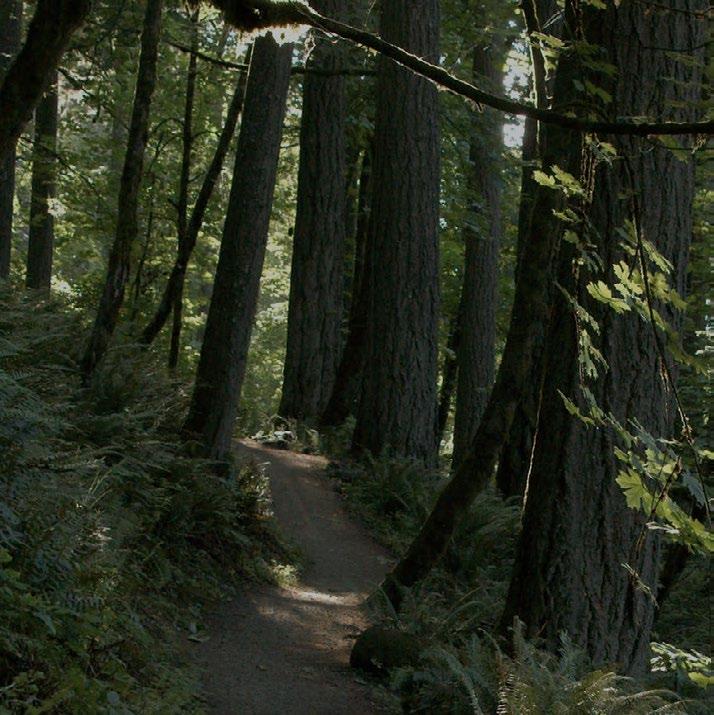
JIM MOCKFORD, BA ’76 (Clark Honors College, Asian studies), was featured by the Los Angeles Times Festival of Books as coauthor of the illustrated children’s book, The Kite That Touched the Sky.
In recognition of her career as a journalist, ANN CURRY, BA ’78 (journalism), received the Murrow Lifetime Achievement Award in Broadcast Journalism at the forty-sixth Murrow
Symposium at Washington State University in Pullman.
STAN ELLIOT, BS ’78 (marketing), continues work in the wood pellet business from his home outside Seattle with wife, Lisa, while spending time with four sons and five grandchildren, fly fishing, traveling, gardening, and proudly wearing green and yellow.

MIKE GAYNES, BS ’78 (journalism), was profiled in a California Public Television documentary titled More Than Skin Deep— Surviving Melanoma, as one of the earliest breakthrough survivors of stage 4 melanoma, a cancer that was often fatal prior to the recent development of immunotherapy.

Singer-songwriters
DAVID ANTONUCCIO, MA ’79, PhD ’80 (psychology), and MICHAEL PIERCE, PhD ’82 (chemistry), formed the musical
Subscribe
Making News for Racial Healing
duo RainFall and are working on a third album, Cloudburst, available on Soundcloud.
MARGIE YAP, BA ’79 (journalism), was featured by Oregon ArtsWatch for her lifelong study of the Japanese tea ceremony and her business, Issoan Tea School, run from her home in Portland.
1980s
ANTHONY
NEIL EVERETT
MORFITT, BS ’84 (journalism), a longtime ESPN SportsCenter anchor, joined the NBA Portland Trail Blazers broadcast team.
VICTORIA
SCHMIDT, BS ’84 (physical education), assistant principal at May Street Elementary School in the Hood River County School District, was appointed principal.
general manager for Nike North America and the first Black woman in this role with the company, was featured in Footwear News as a trailblazer in business.
AMY
CHAUMETON, BA ’88, MS ’90 (physical education), was named vice president and chief medical officer at Legacy Emanuel Medical Center in Portland.
NBCUniversal
News Group—which includes NBC News, MSNBC, and CNBC—in June issued a press release announcing a collaboration with the W. K. Kellogg Foundation in support of racial healing.
And the NBC spokesperson listed at the top of the announcement? Lorie Acio.
The rise to the upper echelons of the news industry has been rapid for Acio, a 2011 Clark Honors College graduate who majored in electronic media production in the School of Journalism and Communication. After taking an unpaid internship with CBS News following graduation, Acio rose quickly through the ranks. Within roughly three years, she had moved to NBC to become a senior publicist for MSNBC; today she is vice president of communications for MSNBC.
Acio credits the honors college for shaping her as a person and giving her the confidence to “speak in any meeting,” she says. She honed reportorial skills in the journalism school, working in print and broadcast news and interning at an ABC affiliate in Portland.
During her time at the university, Acio, who was born in the Philippines, learned to celebrate her multicultural identity while exploring other cultures and identities. She has become a strong advocate for diversity at NBC, overseeing communications on matters of diversity, equity, and inclusion at the NBCUniversal News Group while guiding MSNBC press strategy.

The partnership between the NBCUniversal News Group and the W. K. Kellogg Foundation, one of the largest philanthropic foundations in the United States, includes coverage through early 2023 of leading voices on racial healing, a year’s worth of digital content, and production of an English- and Spanish-language town hall for MSNBC and the Spanish-language network Noticias Telemundo on January 17, the National Day of Racial Healing.
For Acio, it’s another encouraging step forward for cultural understanding that means as much to her personally as professionally.
“As someone who is diverse, there aren’t a lot of people who look like me in my field,” Acio says. “But I’m able to celebrate that and use that to my advantage in terms of helping and trying to make that difference. I hope there are others who can look at me and see my experience and think that anything is possible.”
Matt Cooper, Oregon QuarterlyAUSTIN, BS ’81 (management), MS ’86 (industrial relations), was appointed chief human resource officer at Danimer Scientific, a bioplastics company headquartered in Bainbridge, Georgia.
JUDY
FREDRICKSON, BS ’81 (marketing), of UBS Private Wealth Management in Minnesota, was featured in Forbes as a top wealth advisor.
ERIC SMITH, BS ’82 (accounting), was appointed business development officer for the western US region of CIT, a division of First Citizens Bank.
JOHN HELDT, BS ’85 (journalism, history), published The Fountain, his twenty-first novel, in August.
DOUGLAS
RAMSTHEL, BS ’86 (economics), coauthored the book, Access: Addressing the Obesity Crisis.
ALEX KOLODKIN, PhD ’87 (biology), professor of neuroscience at Johns Hopkins University in Maryland, was elected to the National Academy of Sciences.
SARAH MENSAH, BA ’87 (speech: telecommunication and film, journalism), vice president and
KEVIN PITTS, MS ’89, PhD ’94 (physics), chief research officer at Fermilab National Accelerator Laboratory and professor of physics at the University of Illinois at UrbanaChampaign, was named dean of the Virginia Tech College of Science.
1990s
TIANA TOZER, BA ’90 (Romance languages), a humanitarian worker and former US Paralympian, spoke about road safety and her lifealtering car crash to students at Smithers Secondary School in British Columbia.
PEARL WOLFE,MS ’90 (sociology), a former Lane County supervisor and recipient of a city of Eugene human rights recognition award for her work with the Hope and Safety Alliance (formerly Womenspace), coauthored Walk Out the Door, a novel about domestic violence, with Evelyn Anderton.
AARON WALKER, BS ’91 (marketing), was hired as chief credit officer by Summit Bank of Eugene, Central Oregon, and Portland.
TROY JELINEK, BS ’92 (planning, public policy and management), was named chief commercial officer for Minnesota-based Icario, a health care company.
COREY SCHLOSSERHALL, BS ’92 (speech: rhetoric and communication), was named deputy executive for vision, innovation, and rebuilding for the Presbyterian Mission Agency, the ministry and mission arm of the Presbyterian Church.
BRIAN WRIGHT, BS ’92 (speech: telecommunication and film, journalism: advertising), formerly the longtime chief merchandising officer for the Duck Store, became director of the VolShop at the University of Tennessee, Knoxville.

NICOLE APELIAN, MS ’93 (biology), coauthored The Lost Book of Herbal Remedies: The Healing Power of Plant Medicine, a collection of healing plants and natural remedies.
In September, one thousand firstyear students arrive for freshman week, which includes the Hello Dance, a newstudent picnic, and an old standby: the psych examination, which indicates the “chance of success in college work.”
MARTINA KOLB, MA ’93 (German), associate professor of German studies at Susquehanna University in Pennsylvania, received the John C. Horn Award for Distinguished Scholarship and Creative Activity.
TOM WILLIAMS, BS ’93 (physics), was featured in Atlanta
magazine for his work as a sculptor.
JON WOLLMUTH, BA ’93 (English), became principal at Island Park Elementary School in Washington.
LAURA CLARKE, MS ’96, PhD ’98 (physics), a physics professor in the College of Sciences at North Carolina State
University, received the 2022 UNC Board of Governors Award for Excellence in Teaching.
BRIAN IMUS, BS ’96 (planning, public policy and management), executive director of the Illinois Green Alliance, a nonprofit that works to promote green buildings
FLASHBACK
196A September edition of the Oregon Daily Emerald complains that Old Oregon is free to alumni and should be free to students, for whom the price is thirty-five cents.
and sustainable communities, was recognized as a Notable Leader in Sustainability by Crain’s Chicago Business.
YOLANDA
SUAREZ, BA ’96 (speech: theater arts), played the title role in Alma, a play about a single mother and undocumented immigrant living in the US with her seventeen-yearold daughter, at ArtsWest in Seattle.
ANDY
NUTTBROCK, BLArch ’97, was hired by Olson Engineering of Vancouver, Washington, and will provide land-use planning, project management, and landscape architecture design services.
SCOTT WHITE , BA ’97 (history), a senior director with Alvarez and Marsal Taxand consulting firm, was named among the “People on the
Move” by the San Francisco Business Times
JINOO HWANG, BS ’98 (sociology), JD ’07, managing partner of Northwest Legal in Eugene, was appointed to the State Professional Responsibility Board, which reviews and prosecutes cases involving licensed attorneys in Oregon.
ELIZABETH
MATTEO, BS ’98 (psychology), was named the inaugural dean of the College of Humanities, Education and Social Sciences at Alvernia University in Pennsylvania.
DANIEL McGEE, JD ’98, joined Keller and Heckman, an international law firm with practice in food and food additives and industrial and specialty chemicals.
DAN MOSHAVI, PhD ’98 (management), was selected as Thomas and Evelyn Page
Dean of the Fowler College of Business at San Diego State University.
AMIE BRAIK, BS ’99 (anthropology), a fifth-grade teacher at Nick Poulakidas Elementary School in Nevada, won the Presidential Award for Excellence in Science, Mathematics, and Science Teaching for 2020.
JOSH GOBEL, BS ’99 (environmental studies), a senior project manager with Olympia, Washingtonbased Thomas Architecture Studios, was promoted to associate principal.
2000s
PAUL
MOUCHAKKAA, MBA ’00 (general business), was appointed senior managing director and head of real estate for Alberta Investment Management Corporation, a Canadian fund management company.
EDNEISHA
CURRY, BS ’02 (sociology), who completed her first season as an assistant coach with the Portland Trail Blazers in April, was chosen as keynote speaker for the Oregon Girls Sports Leadership Summit.
MICHAEL KASAHUN, BA ’02 (sociology), organized a march in Eugene to raise awareness about civil war in Tigray, Ethiopia, his home country.
TIFFANY REEVES, BA ’02 (Spanish), JD ’06, an adviser to institutional investor clients in domestic and international private investments, joined Faegre Drinker as a partner in the firm’s investment management practice in Minneapolis.
MANDOLIN
BRASSAW, BA ’03, PhD ’08 (English), was featured in the Seattle Times regarding
FLASHBACK
Grapheme, her combination stationery shop and letterpress studio.
JASON BURROWSÁNCHEZ, PhD ’03 (counseling psychology), a University of Utah psychology professor, was named NCAA Faculty Athletics Representative, representing the institution and faculty in relationships with the NCAA and the Pac-12 Conference.
LUKE LISS, BA ’03 (political science), pro bono partner at Wilson Sonsini in Palo Alto, California, was featured in Bloomberg Law’s “Why Mentoring Matters” series, relating how guidance and encouragement from a pioneering Black partner set him on the path to partnership and success as a litigator.
CHRISTINE
McCARTHY, BS ’03 (geological sciences), Lamont Assistant
Research Professor at Columbia University in New York, was featured on the podcast People Behind Science in a segment titled, “Fascinated by the Forces and Features that Contribute to Flow in Rocks and Ice.”
THEA von GELDERN, BArch ’03, an associate principal and project manager with Allied Works Architecture of Portland, was interviewed by the Portland Business Journal regarding her life and the philosophy of architecture.
LARRY CAVASSO, BS ’04 (economics), was promoted to associate vice president-controller with Portland-based Unitus Community Credit Union.
KELLEN CLEMENS, BS ’05 (business administration), was featured on the New York Jets website, reflecting on five years as quarterback.
199
The university bookstore holds a mock banning of gay literature in October to demonstrate possible effects of Ballot Measure 9, which would require the state to consider homosexuality “abnormal” and “perverse,” according to the Oregon Daily Emerald.
ELIZABETH
TEIGLAND, MS ’05 (chemistry), became manufacturing director for Calyxt, a plantbased synthetic biotechnology company headquartered in Minnesota.
BRIAN THOMAS, BS ’05 (business administration), was promoted to senior vice president and commercial banking team leader of the Portland and Southwest Washington team at Summit Bank.
EMILY ANN FARRELL, BA ’06 (Spanish), JD ’09, was appointed senior director of operations and health equity administrator for Trillium Community Health Plan and Health Net Health Plan of Oregon.
CLAYTON JONES, MBA ’06 (general business) JD ’06, was hired as chief legal officer at Helo, a wearable technology company headquartered in Miami.
JORDAN KENT, BS ’06 (business administration), announced expansion of the summer multisport program, Just Kids Skill Camps, to Mesa, Arizona, after establishing the sport and agility camps in Washington, Oregon, and Idaho.
CHRIS SOLOMONA, BS ’06 (sociology), became head football coach of the Roy High School Royals in Roy, Utah.
JAMIE WEAVER, PhD ’06 (music

don't miss a click!
Next year, Oregon Quarterly will expand its reach and move from a quarterly print publication to an online magazine.
history), a musicologist at Stephen F. Austin University in Texas who lived in Spokane, Washington, was featured by Fox 28 Spokane for International Guide Dog Day to explain what her guide dog, Tag, has meant to her.
JOSH JALBERT, MFA ’07 (photography), a faculty member at Savannah College of Art and Design in Georgia, presented work at Photo London, a photo fair that brings international
photography to the British capital every year.
RYANNE
PILGERAM, MS ’07, PhD ’10 (sociology), published the book, Pushed Out: Contested Development and Rural Gentrification in the US West, detailing the transformation of Dover, Idaho, as an embodiment of challenges for rural communities.
JENNIFER
CARROLL, JD ’08, was promoted to partner at Chicagoarea Newland and Newland.
ROSIE
CLAYBURN , BS ’08 (anthropology), Yurok cultural resources department director and tribal heritage preservation officer, joined the board of directors of Parks California, becoming the first member of Indigenous heritage.
TIFFANY
CRUICKSHANK , BS ’08 (business administration), joined the sales team of Onions 52, a grower in Syracuse, Utah.
You’ll continue to enjoy great stories, compelling features, vivid photography, and current class notes — keeping you connected to campus in a way that is kinder to the earth and more widely available to Ducks everywhere. Four times a year, starting in 2023, we’ll send an email with links to the latest digital edition. We’ll also publish stories and videos of special interest year round. You want to be sure you're on the list!

If you regularly receive the email edition of Oregon Quarterly no action is required.
To sign up for the digital magazine, or learn more about our move, visit:
RACHEL
HERRERA , BA ’08 (communication disorders and sciences), was featured in Authority magazine for launching the website A sweet time to sign, which teaches American Sign Language.
HAMED
ALEAZIZ , BA ’09 (news editorial), who has reported for BuzzFeed News, the San Francisco Chronicle , and Mother Jones , joined the Los Angeles Times to cover immigration policy.
2010s

AMANDA
PFLUGRAD , BS ’10 (electronic media production), team reporter for the Boston Celtics, covered the NBA Finals for the first time.
JACKSON
MORAWSKI , BA ’15 (Asian studies), graduated from the University of California, Berkeley, School of Law with a juris doctor, pro bono honors, and a business law certificate.
M JACKSON , PhD ’17 (geography), a geographer and glaciologist, starred as one of the scientists in Netflix’s Pirate Gold of Adak Island , detailing a story of buried treasure in Alaska.

ISRAEL
ANGELES , MBA ’18 (general business), launched FleetNurse, addressing health care labor shortages by providing a techenabled, gig modelbased approach to staffing.

2020s
ANIKA GRAACK , BS ’21 (Clark Honors College, human physiology), a science teacher at Sunrise Mountain High School in Las Vegas, was named one of seven new educators of the year by the Clark County School District.
DAYLE


SPITZER , DEd ’21 (educational leadership), became superintendent of the Oregon City School District.

COOPER TEARE , BS ’21 (general social science), a
professional trackand-field athlete, was inducted into the 2022 Athletic Hall of Fame at St. Joseph Notre Dame High School in Alameda, California.
IN MEMORIAM
JAMES A. PERRY , BS ’58 (economics), died May 27. A member of Sigma Phi Epsilon, he was a captain in the US Air Force and worked in banking, assuming responsibility for all trust branches of US Bank in Oregon. He served on the faculty of Willamette University College of Law and was a past president of the University of Oregon Alumni Association.
SPENCER WEBB , a general social science major and member of the class of 2023, died July 13. Raised in Sacramento and nicknamed “Spider,” Webb was a tight end for the Ducks football team, amassing thirty-one catches for 296 yards and four touchdowns over twenty-nine games.
News. Worthy. Daily.





















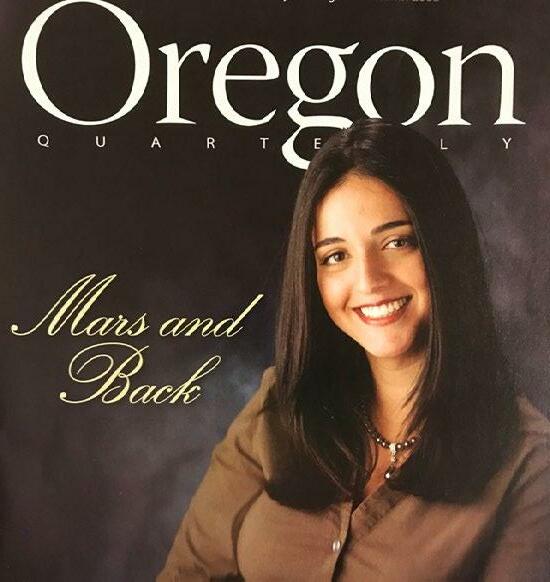








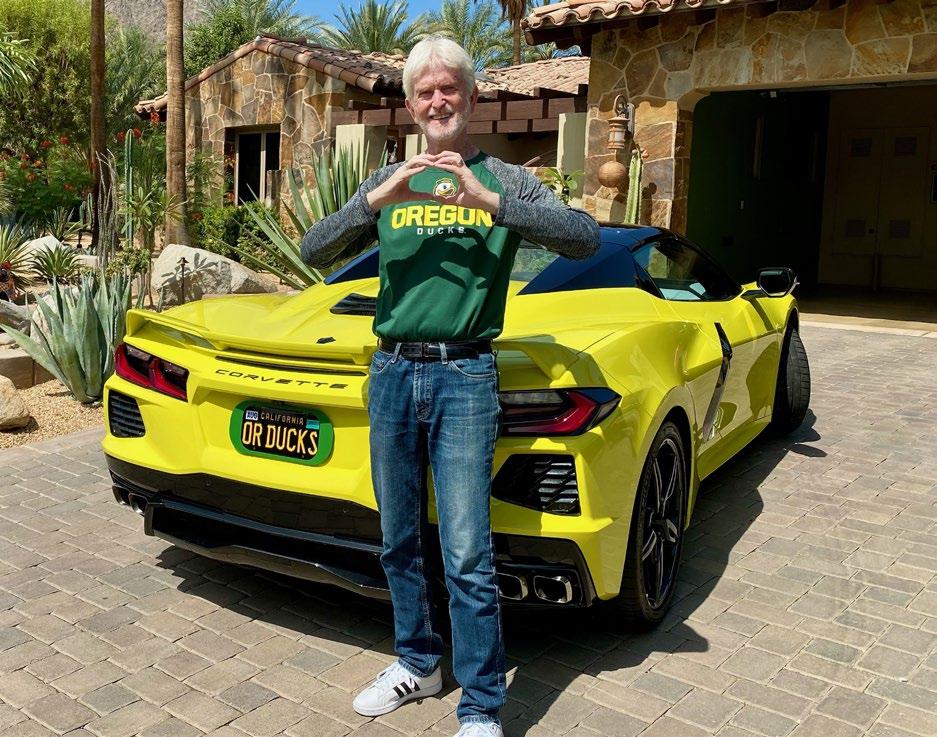







STORY
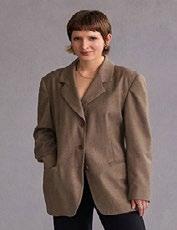
















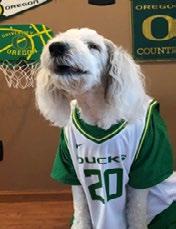






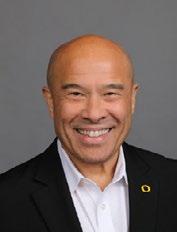






















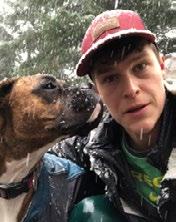










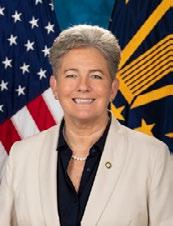












Not My First Rodeo
BY RAPHE BECKIn
September I headed back to Eastern Oregon for the Pendleton Round-Up, and as the saying goes, it was not my first rodeo.
A few years ago, Pendleton was my first rodeo. Last month’s was my second.
I’m from Chicago, and when I prepared for my first Round-Up in 2019, I worried that our alumni in Eastern Oregon would view me as a city slicker . . . since that’s exactly what I am.
To look the part, I found a western clothing store that set me up with a Stetson, an enormous belt buckle, and some boots that cost slightly more than my car.
I tested out my new duds at the office, lingering in the doorway and trying my best to channel Gary Cooper. My colleague Megan happens to be from Texas, and after a minute she glanced up from her work and looked at my outfit. There was a long silence.
Finally, Megan nodded. “You look like a legit cowboy,” she conceded. This was high praise.
It’s a long way from Eugene to Pendleton, and I don’t mean just the distance. Politically and culturally, the cities are pretty different. The University of Oregon hosts a breakfast at the RoundUp where local Ducks and those like me from out of town gather to raise scholarship funds for UO students from the area. The group doesn’t divide itself into red and blue; at the rodeo we’re all yellow and green.
During my first Round-Up, breakfast was emceed by state senator Bill Hansell, who represents Umatilla and neighboring counties in northeast Oregon. Bill is a proud UO alumnus, and he likes to be called “Senator Duck.” He’s about the friendliest person you’ve ever met.
After breakfast, it was rodeo time. I watched with awe as cowboys and cowgirls roped calves and rode broncos. At one point a stunt rider rode two horses bareback as they jumped over a row of flames. I’m not sure exactly how this skill is used on a ranch, but I was certainly impressed.
Senator Duck came by to check in, and a colleague let him know that this was my first rodeo. The senator’s face lit up. “Well, you’ll want to come back behind the chute and see things up close,” he said. He gestured for me to follow him around the stadium.

We emerged onto a narrow stage, in front of which were the wooden gates where animals and riders filed in. There was very little room. If we had been on a subway platform, I would have preferred to stand a little farther back from the edge.
An enormous bull was led up the chute, and a cowboy gingerly
lowered himself onto the agitated beast. The gate sprang open and the rider was flung around like a rag doll just a few feet from where we stood. I was anxious for him, but also for myself because that rider was surely about to become a projectile.
Meanwhile, Senator Duck was politely getting to know me. “Raphe, you got any kids?”
The bull bucked the rider off right in front of us. Several tons of future hamburger danced around, nearly trampling him. I had a hard time focusing. Do I have kids?
“Uh, yes sir, a daughter. I think.”
Rodeo clowns tried to distract the bull. Was this normal? It seemed like an emergency but everyone besides the bull was totally chill.
The cowboy, who I thought by now was an ex-cowboy, miraculously popped up and vaulted over the fence. I tipped my Stetson to him.
Senator Duck and I spent the afternoon repeating this pattern: friendly chatter, angry bull, rider nearly trampled, back to chatter. By the end of the day, it didn’t faze me at all.
If you didn’t make it to Pendleton for the Round-Up this year, I hope to see you at another one soon. If I feel like it, I just might jump a couple of horses bareback over a row of fire. Don’t laugh—I’m a legit cowboy.
Raphe Beck is executive director of the UO Alumni Association.






